British Museum
The British Museum, in the Bloomsbury area of London, United Kingdom, is a public institution dedicated to human history, art and culture. Its permanent collection of some eight million works is among the largest and most comprehensive in existence,[3] having been widely sourced during the era of the British Empire. It documents the story of human culture from its beginnings to the present.[lower-alpha 1] It was the first public national museum in the world.[4]
.jpg) | |
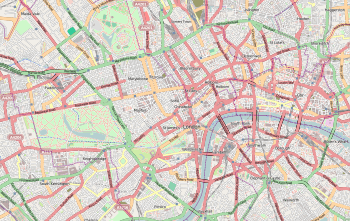 Location within central London | |
| Established | 1753 |
|---|---|
| Location | Great Russell Street, London, England, United Kingdom |
| Coordinates | 51.5195°N 0.1269°W |
| Collection size | approx. 8 million objects[1] |
| Visitors | 6,239,983 (2019) [2]
|
| Chairman | Sir Richard Lambert |
| Director | Hartwig Fischer |
| Public transit access | |
| Website | www |
| Area | 807,000 sq ft (75,000 m2) in 94 galleries |

The British Museum was established in 1753, largely based on the collections of the Irish physician and scientist Sir Hans Sloane.[5] It first opened to the public in 1759, in Montagu House, on the site of the current building. Its expansion over the following 250 years was largely a result of expanding British colonisation and has resulted in the creation of several branch institutions, the first being the Natural History Museum in 1881.
In 1973, the British Library Act 1972 detached the library department from the British Museum, but it continued to host the now separated British Library in the same Reading Room and building as the museum until 1997. The museum is a non-departmental public body sponsored by the Department for Digital, Culture, Media and Sport, and as with all national museums in the UK it charges no admission fee, except for loan exhibitions.[6]
Its ownership of some of its most famous objects originating in other countries is disputed and remains the subject of international controversy, most notably in the case of the Elgin Marbles[7] of Greece and the Rosetta Stone[8] of Egypt.
History
Sir Hans Sloane
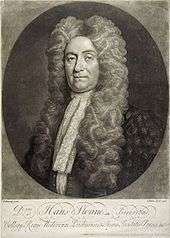
Although today principally a museum of cultural art objects and antiquities, the British Museum was founded as a "universal museum". Its foundations lie in the will of the Irish physician and naturalist Sir Hans Sloane (1660–1753), a London-based doctor and scientist from Ulster. During the course of his lifetime, and particularly after he married the widow of a wealthy Jamaican planter,[9] Sloane gathered a large collection of curiosities and, not wishing to see his collection broken up after death, he bequeathed it to King George II, for the nation, for a sum of £20,000.[10]
At that time, Sloane's collection consisted of around 71,000 objects of all kinds[11] including some 40,000 printed books, 7,000 manuscripts, extensive natural history specimens including 337 volumes of dried plants, prints and drawings including those by Albrecht Dürer and antiquities from Sudan, Egypt, Greece, Rome, the Ancient Near and Far East and the Americas.[12]
Foundation (1753)
On 7 June 1753, King George II gave his Royal Assent to the Act of Parliament which established the British Museum.[lower-alpha 2] The British Museum Act 1753 also added two other libraries to the Sloane collection, namely the Cottonian Library, assembled by Sir Robert Cotton, dating back to Elizabethan times, and the Harleian Library, the collection of the Earls of Oxford. They were joined in 1757 by the "Old Royal Library", now the Royal manuscripts, assembled by various British monarchs. Together these four "foundation collections" included many of the most treasured books now in the British Library[14] including the Lindisfarne Gospels and the sole surviving manuscript of Beowulf.[lower-alpha 3]

The British Museum was the first of a new kind of museum – national, belonging to neither church nor king, freely open to the public and aiming to collect everything. Sloane's collection, while including a vast miscellany of objects, tended to reflect his scientific interests.[15] The addition of the Cotton and Harley manuscripts introduced a literary and antiquarian element, and meant that the British Museum now became both National Museum and library.[16]
Cabinet of curiosities (1753–1778)

The body of trustees decided on a converted 17th-century mansion, Montagu House, as a location for the museum, which it bought from the Montagu family for £20,000. The trustees rejected Buckingham House, on the site now occupied by Buckingham Palace, on the grounds of cost and the unsuitability of its location.[17][lower-alpha 4]
With the acquisition of Montagu House, the first exhibition galleries and reading room for scholars opened on 15 January 1759.[18] At this time, the largest parts of collection were the library, which took up the majority of the rooms on the ground floor of Montagu House, and the natural history objects, which took up an entire wing on the second state storey of the building. In 1763, the trustees of the British Museum, under the influence of Peter Collinson and William Watson, employed the former student of Carl Linnaeus, Daniel Solander, to reclassify the natural history collection according to the Linnaean system, thereby making the Museum a public centre of learning accessible to the full range of European natural historians.[19] In 1823, King George IV gave the King's Library assembled by George III,[20] and Parliament gave the right to a copy of every book published in the country, thereby ensuring that the museum's library would expand indefinitely. During the few years after its foundation the British Museum received several further gifts, including the Thomason Collection of Civil War Tracts and David Garrick's library of 1,000 printed plays. The predominance of natural history, books and manuscripts began to lessen when in 1772 the museum acquired for £8,410 its first significant antiquities in Sir William Hamilton's "first" collection of Greek vases.[21]
Indolence and energy (1778–1800)

From 1778, a display of objects from the South Seas brought back from the round-the-world voyages of Captain James Cook and the travels of other explorers fascinated visitors with a glimpse of previously unknown lands. The bequest of a collection of books, engraved gems, coins, prints and drawings by Clayton Mordaunt Cracherode in 1800 did much to raise the museum's reputation; but Montagu House became increasingly crowded and decrepit and it was apparent that it would be unable to cope with further expansion.[22]
The museum's first notable addition towards its collection of antiquities, since its foundation, was by Sir William Hamilton (1730–1803), British Ambassador to Naples, who sold his collection of Greek and Roman artefacts to the museum in 1784 together with a number of other antiquities and natural history specimens. A list of donations to the museum, dated 31 January 1784, refers to the Hamilton bequest of a "Colossal Foot of an Apollo in Marble". It was one of two antiquities of Hamilton's collection drawn for him by Francesco Progenie, a pupil of Pietro Fabris, who also contributed a number of drawings of Mount Vesuvius sent by Hamilton to the Royal Society in London.
Growth and change (1800–1825)
In the early 19th century the foundations for the extensive collection of sculpture began to be laid and Greek, Roman and Egyptian artefacts dominated the antiquities displays. After the defeat of the French campaign in the Battle of the Nile, in 1801, the British Museum acquired more Egyptian sculptures and in 1802 King George III presented the Rosetta Stone – key to the deciphering of hieroglyphs.[23] Gifts and purchases from Henry Salt, British consul general in Egypt, beginning with the Colossal bust of Ramesses II in 1818, laid the foundations of the collection of Egyptian Monumental Sculpture.[24] Many Greek sculptures followed, notably the first purpose-built exhibition space, the Charles Towneley collection, much of it Roman sculpture, in 1805. In 1806, Thomas Bruce, 7th Earl of Elgin, ambassador to the Ottoman Empire from 1799 to 1803 removed the large collection of marble sculptures from the Parthenon, on the Acropolis in Athens and transferred them to the UK. In 1816 these masterpieces of western art were acquired by The British Museum by Act of Parliament and deposited in the museum thereafter.[25] The collections were supplemented by the Bassae frieze from Phigaleia, Greece in 1815. The Ancient Near Eastern collection also had its beginnings in 1825 with the purchase of Assyrian and Babylonian antiquities from the widow of Claudius James Rich.[26]
In 1802 a buildings committee was set up to plan for expansion of the museum, and further highlighted by the donation in 1822 of the King's Library, personal library of King George III's, comprising 65,000 volumes, 19,000 pamphlets, maps, charts and topographical drawings.[27] The neoclassical architect, Sir Robert Smirke, was asked to draw up plans for an eastern extension to the museum "... for the reception of the Royal Library, and a Picture Gallery over it ..."[28] and put forward plans for today's quadrangular building, much of which can be seen today. The dilapidated Old Montagu House was demolished and work on the King's Library Gallery began in 1823. The extension, the East Wing, was completed by 1831. However, following the founding of the National Gallery, London in 1824,[lower-alpha 5] the proposed Picture Gallery was no longer needed, and the space on the upper floor was given over to the Natural history collections.[29]
The largest building site in Europe (1825–1850)
.jpg)
The museum became a construction site as Sir Robert Smirke's grand neo-classical building gradually arose. The King's Library, on the ground floor of the East Wing, was handed over in 1827, and was described as one of the finest rooms in London. Although it was not fully open to the general public until 1857, special openings were arranged during The Great Exhibition of 1851. In spite of dirt and disruption the collections grew, outpacing the new building.
In 1840, the museum became involved in its first overseas excavations, Charles Fellows's expedition to Xanthos, in Asia Minor, whence came remains of the tombs of the rulers of ancient Lycia, among them the Nereid and Payava monuments. In 1857, Charles Newton was to discover the 4th-century BC Mausoleum of Halikarnassos, one of the Seven Wonders of the Ancient World. In the 1840s and 1850s the museum supported excavations in Assyria by A.H. Layard and others at sites such as Nimrud and Nineveh. Of particular interest to curators was the eventual discovery of Ashurbanipal's great library of cuneiform tablets, which helped to make the museum a focus for Assyrian studies.[30]
Sir Thomas Grenville (1755–1846), a trustee of the British Museum from 1830, assembled a library of 20,240 volumes, which he left to the museum in his will. The books arrived in January 1847 in twenty-one horse-drawn vans. The only vacant space for this large library was a room originally intended for manuscripts, between the Front Entrance Hall and the Manuscript Saloon. The books remained here until the British Library moved to St Pancras in 1998.
Collecting from the wider world (1850–1875)
The opening of the forecourt in 1852 marked the completion of Robert Smirke's 1823 plan, but already adjustments were having to be made to cope with the unforeseen growth of the collections. Infill galleries were constructed for Assyrian sculptures and Sydney Smirke's Round Reading Room, with space for a million books, opened in 1857. Because of continued pressure on space the decision was taken to move natural history to a new building in South Kensington, which would later become the British Museum of Natural History.
Roughly contemporary with the construction of the new building was the career of a man sometimes called the "second founder" of the British Museum, the Italian librarian Anthony Panizzi. Under his supervision, the British Museum Library (now part of the British Library) quintupled in size and became a well-organised institution worthy of being called a national library, the largest library in the world after the National Library of Paris.[16] The quadrangle at the centre of Smirke's design proved to be a waste of valuable space and was filled at Panizzi's request by a circular Reading Room of cast iron, designed by Smirke's brother, Sydney Smirke.[31]
Until the mid-19th century, the museum's collections were relatively circumscribed but, in 1851, with the appointment to the staff of Augustus Wollaston Franks to curate the collections, the museum began for the first time to collect British and European medieval antiquities, prehistory, branching out into Asia and diversifying its holdings of ethnography. A real coup for the museum was the purchase in 1867, over French objections, of the Duke of Blacas's wide-ranging and valuable collection of antiquities. Overseas excavations continued and John Turtle Wood discovered the remains of the 4th century BC Temple of Artemis at Ephesos, another Wonder of the Ancient World.[32]
Scholarship and legacies (1875–1900)
The natural history collections were an integral part of the British Museum until their removal to the new British Museum of Natural History in 1887, nowadays the Natural History Museum. With the departure and the completion of the new White Wing (fronting Montague Street) in 1884, more space was available for antiquities and ethnography and the library could further expand. This was a time of innovation as electric lighting was introduced in the Reading Room and exhibition galleries.[33]
The William Burges collection of armoury was bequeathed to the museum in 1881. In 1882, the museum was involved in the establishment of the independent Egypt Exploration Fund (now Society) the first British body to carry out research in Egypt. A bequest from Miss Emma Turner in 1892 financed excavations in Cyprus. In 1897 the death of the great collector and curator, A. W. Franks, was followed by an immense bequest of 3,300 finger rings, 153 drinking vessels, 512 pieces of continental porcelain, 1,500 netsuke, 850 inro, over 30,000 bookplates and miscellaneous items of jewellery and plate, among them the Oxus Treasure.[34]
In 1898 Baron Ferdinand de Rothschild bequeathed the Waddesdon Bequest, the glittering contents from his New Smoking Room at Waddesdon Manor. This consisted of almost 300 pieces of objets d'art et de vertu which included exquisite examples of jewellery, plate, enamel, carvings, glass and maiolica, among them the Holy Thorn Reliquary, probably created in the 1390s in Paris for John, Duke of Berry. The collection was in the tradition of a Schatzkammer such as those formed by the Renaissance princes of Europe.[35] Baron Ferdinand's will was most specific, and failure to observe the terms would make it void, the collection should be
placed in a special room to be called the Waddesdon Bequest Room separate and apart from the other contents of the Museum and thenceforth for ever thereafter, keep the same in such room or in some other room to be substituted for it.[35]
These terms are still observed, and the collection occupies room 2a.
New century, new building (1900–1925)
.2.jpg)

By the last years of the 19th century, The British Museum's collections had increased to the extent that its building was no longer large enough. In 1895 the trustees purchased the 69 houses surrounding the museum with the intention of demolishing them and building around the west, north and east sides of the museum. The first stage was the construction of the northern wing beginning 1906.
All the while, the collections kept growing. Emil Torday collected in Central Africa, Aurel Stein in Central Asia, D.G. Hogarth, Leonard Woolley and T. E. Lawrence excavated at Carchemish. Around this time, the American collector and philanthropist J Pierpont Morgan donated a substantial number of objects to the museum,[36] including William Greenwell's collection of prehistoric artefacts from across Europe which he had purchased for £10,000 in 1908. Morgan had also acquired a major part of Sir John Evans's coin collection, which was later sold to the museum by his son John Pierpont Morgan Junior in 1915. In 1918, because of the threat of wartime bombing, some objects were evacuated via the London Post Office Railway to Holborn, the National Library of Wales (Aberystwyth) and a country house near Malvern. On the return of antiquities from wartime storage in 1919 some objects were found to have deteriorated. A conservation laboratory was set up in May 1920 and became a permanent department in 1931. It is today the oldest in continuous existence.[37] In 1923, the British Museum welcomed over one million visitors.
Disruption and reconstruction (1925–1950)
New mezzanine floors were constructed and book stacks rebuilt in an attempt to cope with the flood of books. In 1931, the art dealer Sir Joseph Duveen offered funds to build a gallery for the Parthenon sculptures. Designed by the American architect John Russell Pope, it was completed in 1938. The appearance of the exhibition galleries began to change as dark Victorian reds gave way to modern pastel shades.[lower-alpha 6] However, in August 1939, due to the imminence of war and the likelihood of air-raids, the Parthenon Sculptures, along with the museum's most valued collections, were dispersed to secure basements, country houses, Aldwych Underground station, the National Library of Wales and a quarry. The evacuation was timely, for in 1940 the Duveen Gallery was severely damaged by bombing.[39] Meanwhile, prior to the war, the Nazis had sent a researcher to the British Museum for several years with the aim of "compiling an anti-Semitic history of Anglo-Jewry".[40] After the war, the museum continued to collect from all countries and all centuries: among the most spectacular additions were the 2600 BC Mesopotamian treasure from Ur, discovered during Leonard Woolley's 1922–34 excavations. Gold, silver and garnet grave goods from the Anglo-Saxon ship burial at Sutton Hoo (1939) and late Roman silver tableware from Mildenhall, Suffolk (1946). The immediate post-war years were taken up with the return of the collections from protection and the restoration of the museum after the Blitz. Work also began on restoring the damaged Duveen Gallery.
A new public face (1950–1975)
.jpg)
In 1953, the museum celebrated its bicentenary. Many changes followed: the first full-time in-house designer and publications officer were appointed in 1964, the Friends organisation was set up in 1968, an Education Service established in 1970 and publishing house in 1973. In 1963, a new Act of Parliament introduced administrative reforms. It became easier to lend objects, the constitution of the board of trustees changed and the Natural History Museum became fully independent. By 1959 the Coins and Medals office suite, completely destroyed during the war, was rebuilt and re-opened, attention turned towards the gallery work with new tastes in design leading to the remodelling of Robert Smirke's Classical and Near Eastern galleries.[41] In 1962 the Duveen Gallery was finally restored and the Parthenon Sculptures were moved back into it, once again at the heart of the museum.[lower-alpha 7]
By the 1970s the museum was again expanding. More services for the public were introduced; visitor numbers soared, with the temporary exhibition "Treasures of Tutankhamun" in 1972, attracting 1,694,117 visitors, the most successful in British history. In the same year the Act of Parliament establishing the British Library was passed, separating the collection of manuscripts and printed books from the British Museum. This left the museum with antiquities; coins, medals and paper money; prints & drawings; and ethnography. A pressing problem was finding space for additions to the library which now required an extra 1 1⁄4 miles (2.0 km) of shelving each year. The Government suggested a site at St Pancras for the new British Library but the books did not leave the museum until 1997.
The Great Court emerges (1975–2000)
The departure of the British Library to a new site at St Pancras, finally achieved in 1998, provided the space needed for the books. It also created the opportunity to redevelop the vacant space in Robert Smirke's 19th-century central quadrangle into the Queen Elizabeth II Great Court – the largest covered square in Europe – which opened in 2000. The ethnography collections, which had been housed in the short-lived Museum of Mankind at 6 Burlington Gardens from 1970, were returned to new purpose-built galleries in the museum in 2000.
The museum again readjusted its collecting policies as interest in "modern" objects: prints, drawings, medals and the decorative arts reawakened. Ethnographical fieldwork was carried out in places as diverse as New Guinea, Madagascar, Romania, Guatemala and Indonesia and there were excavations in the Near East, Egypt, Sudan and the UK. The Weston Gallery of Roman Britain, opened in 1997, displayed a number of recently discovered hoards which demonstrated the richness of what had been considered an unimportant part of the Roman Empire. The museum turned increasingly towards private funds for buildings, acquisitions and other purposes.[43]
The British Museum today

Today the museum no longer houses collections of natural history, and the books and manuscripts it once held now form part of the independent British Library. The museum nevertheless preserves its universality in its collections of artefacts representing the cultures of the world, ancient and modern. The original 1753 collection has grown to over 13 million objects at the British Museum, 70 million at the Natural History Museum and 150 million at the British Library.
The Round Reading Room, which was designed by the architect Sydney Smirke, opened in 1857. For almost 150 years researchers came here to consult the museum's vast library. The Reading Room closed in 1997 when the national library (the British Library) moved to a new building at St Pancras. Today it has been transformed into the Walter and Leonore Annenberg Centre.
With the bookstacks in the central courtyard of the museum empty, the demolition for Lord Foster's glass-roofed Great Court could begin. The Great Court, opened in 2000, while undoubtedly improving circulation around the museum, was criticised for having a lack of exhibition space at a time when the museum was in serious financial difficulties and many galleries were closed to the public. At the same time the African collections that had been temporarily housed in 6 Burlington Gardens were given a new gallery in the North Wing funded by the Sainsbury family – with the donation valued at £25 million.[44]
As part of its very large website, the museum has the largest online database of objects in the collection of any museum in the world, with 2,000,000 individual object entries, 650,000 of them illustrated, online at the start of 2012.[45] There is also a "Highlights" database with longer entries on over 4,000 objects, and several specialised online research catalogues and online journals (all free to access).[46] In 2013 the museum's website received 19.5 millions visits, an increase of 47% from the previous year.[47]
In 2013 the museum received a record 6.7 million visitors, an increase of 20% from the previous year.[47] Popular exhibitions including "Life and Death in Pompeii and Herculaneum" and "Ice Age Art" are credited with helping fuel the increase in visitors.[48] Plans were announced in September 2014 to recreate the entire building along with all exhibits in the video game Minecraft in conjunction with members of the public.[49]
Governance
The British Museum is a non-departmental public body sponsored by the Department for Digital, Culture, Media and Sport through a three-year funding agreement. Its head is the Director of the British Museum. The British Museum was run from its inception by a 'principal librarian' (when the book collections were still part of the museum), a role that was renamed 'director and principal librarian' in 1898, and 'director' in 1973 (on the separation of the British Library).[50]
A board of 25 trustees (with the director as their accounting officer for the purposes of reporting to Government) is responsible for the general management and control of the museum, in accordance with the British Museum Act 1963 and the Museums and Galleries Act 1992.[51] Prior to the 1963 Act, it was chaired by the Archbishop of Canterbury, the Lord Chancellor and the Speaker of the House of Commons. The board was formed on the museum's inception to hold its collections in trust for the nation without actually owning them themselves, and now fulfil a mainly advisory role. Trustee appointments are governed by the regulatory framework set out in the code of practice on public appointments issued by the Office of the Commissioner for Public Appointments.[52]
Building
The Greek Revival façade facing Great Russell Street is a characteristic building of Sir Robert Smirke, with 44 columns in the Ionic order 45 ft (14 m) high, closely based on those of the temple of Athena Polias at Priene in Asia Minor. The pediment over the main entrance is decorated by sculptures by Sir Richard Westmacott depicting The Progress of Civilisation, consisting of fifteen allegorical figures, installed in 1852.
The construction commenced around the courtyard with the East Wing (The King's Library) in 1823–1828, followed by the North Wing in 1833–1838, which originally housed among other galleries a reading room, now the Wellcome Gallery. Work was also progressing on the northern half of the West Wing (The Egyptian Sculpture Gallery) 1826–1831, with Montagu House demolished in 1842 to make room for the final part of the West Wing, completed in 1846, and the South Wing with its great colonnade, initiated in 1843 and completed in 1847, when the Front Hall and Great Staircase were opened to the public.[53] The museum is faced with Portland stone, but the perimeter walls and other parts of the building were built using Haytor granite from Dartmoor in South Devon, transported via the unique Haytor Granite Tramway.[54]



In 1846 Robert Smirke was replaced as the museum's architect by his brother Sydney Smirke, whose major addition was the Round Reading Room 1854–1857; at 140 feet (43 m) in diameter it was then the second widest dome in the world, the Pantheon in Rome being slightly wider.
The next major addition was the White Wing 1882–1884 added behind the eastern end of the South Front, the architect being Sir John Taylor.
In 1895, Parliament gave the museum trustees a loan of £200,000 to purchase from the Duke of Bedford all 69 houses which backed onto the museum building in the five surrounding streets – Great Russell Street, Montague Street, Montague Place, Bedford Square and Bloomsbury Street.[55] The trustees planned to demolish these houses and to build around the west, north and east sides of the museum new galleries that would completely fill the block on which the museum stands. The architect Sir John James Burnet was petitioned to put forward ambitious long-term plans to extend the building on all three sides. Most of the houses in Montague Place were knocked down a few years after the sale. Of this grand plan only the Edward VII galleries in the centre of the North Front were ever constructed, these were built 1906–14 to the design by J.J. Burnet, and opened by King George V and Queen Mary in 1914. They now house the museum's collections of Prints and Drawings and Oriental Antiquities. There was not enough money to put up more new buildings, and so the houses in the other streets are nearly all still standing.
The Duveen Gallery, sited to the west of the Egyptian, Greek & Assyrian sculpture galleries, was designed to house the Elgin Marbles by the American Beaux-Arts architect John Russell Pope. Although completed in 1938, it was hit by a bomb in 1940 and remained semi-derelict for 22 years, before reopening in 1962. Other areas damaged during World War II bombing included: in September 1940 two unexploded bombs hit the Edward VII galleries, the King's Library received a direct hit from a high explosive bomb, incendiaries fell on the dome of the Round Reading Room but did little damage; on the night of 10 to 11 May 1941 several incendiaries fell on the south-west corner of the museum, destroying the book stack and 150,000 books in the courtyard and the galleries around the top of the Great Staircase – this damage was not fully repaired until the early 1960s.[56]
The Queen Elizabeth II Great Court is a covered square at the centre of the British Museum designed by the engineers Buro Happold and the architects Foster and Partners.[57] The Great Court opened in December 2000 and is the largest covered square in Europe. The roof is a glass and steel construction, built by an Austrian steelwork company,[58] with 1,656 uniquely shaped panes of glass. At the centre of the Great Court is the Reading Room vacated by the British Library, its functions now moved to St Pancras. The Reading Room is open to any member of the public who wishes to read there.
Today, the British Museum has grown to become one of the largest museums in the world, covering an area of over 92,000 m2 (990,000 sq. ft).[3][59] In addition to 21,600 m2 (232,000 sq. ft)[60] of on-site storage space, and 9,400 m2 (101,000 sq. ft)[60] of external storage space. Altogether the British Museum showcases on public display less than 1%[60] of its entire collection, approximately 50,000 items.[61] There are nearly one hundred galleries open to the public, representing 2 miles (3.2 km) of exhibition space, although the less popular ones have restricted opening times. However, the lack of a large temporary exhibition space has led to the £135 million World Conservation and Exhibition Centre to provide one and to concentrate all the museum's conservation facilities into one Conservation Centre. This project was announced in July 2007, with the architects Rogers Stirk Harbour and Partners. It was granted planning permission in December 2009 and was completed in time for the Viking exhibition in March 2014.[62][63]
Blythe House in West Kensington is used by the museum for off-site storage of small and medium-sized artefacts, and Franks House in East London is used for storage and work on the "Early Prehistory" – Palaeolithic and Mesolithic – and some other collections.[64]
Departments
Department of Egypt and Sudan
The British Museum houses the world's largest[lower-alpha 8] and most comprehensive collection of Egyptian antiquities (with over 100,000[65] pieces) outside the Egyptian Museum in Cairo. A collection of immense importance for its range and quality, it includes objects of all periods from virtually every site of importance in Egypt and the Sudan. Together, they illustrate every aspect of the cultures of the Nile Valley (including Nubia), from the Predynastic Neolithic period (c. 10,000 BC) through Coptic (Christian) times (12th century AD), and up to the present day, a time-span over 11,000 years.[66]
Egyptian antiquities have formed part of the British Museum collection ever since its foundation in 1753 after receiving 160 Egyptian objects[67] from Sir Hans Sloane. After the defeat of the French forces under Napoleon at the Battle of the Nile in 1801, the Egyptian antiquities collected were confiscated by the British army and presented to the British Museum in 1803. These works, which included the famed Rosetta Stone, were the first important group of large sculptures to be acquired by the museum. Thereafter, the UK appointed Henry Salt as consul in Egypt who amassed a huge collection of antiquities, some of which were assembled and transported with great ingenuity by the famous Italian explorer Giovanni Belzoni. Most of the antiquities Salt collected were purchased by the British Museum and the Musée du Louvre.
By 1866 the collection consisted of some 10,000 objects. Antiquities from excavations started to come to the museum in the latter part of the 19th century as a result of the work of the Egypt Exploration Fund under the efforts of E.A. Wallis Budge. Over the years more than 11,000 objects came from this source, including pieces from Amarna, Bubastis and Deir el-Bahari. Other organisations and individuals also excavated and donated objects to the British Museum, including Flinders Petrie's Egypt Research Account and the British School of Archaeology in Egypt, as well as the University of Oxford Expedition to Kawa and Faras in Sudan.
Active support by the museum for excavations in Egypt continued to result in important acquisitions throughout the 20th century until changes in antiquities laws in Egypt led to the suspension of policies allowing finds to be exported, although divisions still continue in Sudan. The British Museum conducted its own excavations in Egypt where it received divisions of finds, including Asyut (1907), Mostagedda and Matmar (1920s), Ashmunein (1980s) and sites in Sudan such as Soba, Kawa and the Northern Dongola Reach (1990s). The size of the Egyptian collections now stand at over 110,000 objects.[68]
In autumn 2001 the eight million objects forming the museum's permanent collection were further expanded by the addition of six million objects from the Wendorf Collection of Egyptian and Sudanese Prehistory.[69] These were donated by Professor Fred Wendorf of Southern Methodist University in Texas, and comprise the entire collection of artefacts and environmental remains from his excavations at Prehistoric sites in the Sahara Desert between 1963 and 1997. Other fieldwork collections have recently come from Dietrich and Rosemarie Klemm (University of Munich) and William Adams (University of Kentucky).
The seven permanent Egyptian galleries at the British Museum, which include its largest exhibition space (Room 4, for monumental sculpture), can display only 4% of its Egyptian holdings. The second-floor galleries have a selection of the museum's collection of 140 mummies and coffins, the largest outside Cairo. A high proportion of the collection comes from tombs or contexts associated with the cult of the dead, and it is these pieces, in particular the mummies, that remain among the most eagerly sought-after exhibits by visitors to the museum.
Key highlights of the collections include:

Predynastic and Early Dynastic period (c. 6000 BC – c. 2690 BC)
- Mummy of Ginger from Gebelein, (c. 3400 BC)
- The Battlefield Palette and Hunters Palette, two cosmetic palettes with complex decorative schemes, (c. 3100 BC)
- Stela of King Peribsen, Abydos, (c. 2720–2710 BC)
Old Kingdom (2690–2181 BC)
- Granite statue of Ankhwa, the shipbuilder, Saqqara, Egypt, 3rd Dynasty, (around 2650 BC)
- Several of the original casing stones from the Great Pyramid of Giza, one of the Seven Wonders of the Ancient World, (c. 2570 BC)
- Wooden tomb statue of Tjeti, Fifth to Sixth Dynasty, (about 2345–2181 BC)
Middle Kingdom (2134–1690 BC)
- Inner and outer coffin of Sebekhetepi, Beni Hasan, (about 2125–1795 BC)
- Limestone stela of Heqaib, Abydos, Egypt, 12th Dynasty, (1990–1750 BC)
- Block statue and stela of Sahathor, 12th Dynasty, reign of Amenemhat II, (c. 1922–1878 BC)
New Kingdom (1549–1069 BC)
- Fragment of the beard of the Great Sphinx of Giza, (14th century BC)
- Colossal head from a statue of Amenhotep III, (1350 BC)
- Colossal limestone bust of Amenhotep III, (1350 BC)
- Amarna Tablets, 99 out of 382 tablets found, second greatest collection in the world after the Vorderasiatisches Museum, Berlin (203 tablets), (1350 BC)
- List of the kings of Egypt from the Temple of Ramesses II, (1250 BC)
Third Intermediate Period (1069–664 BC)
- Mummy case and coffin of Nesperennub, Thebes, (c. 800 BC)
- Statue of Amun in the form of a ram protecting King Taharqa, (683 BC)
- Inner and outer coffins of the priest Hor, Deir el-Bahari, Thebes, 25th Dynasty, (about 680 BC)
Late Period (664–332 BC)
- Saite Sarcophagus of Satsobek, the vizier (prime minister) of the northern part of Egypt in the reign of Psammetichus I, (664–610 BC)
- Bronze figure of Isis and Horus, North Saqqara, Egypt, (600 BC)
- Obelisks and sarcophagus of Pharaoh Nectanebo II, (360–343 BC)
Ptolemaic dynasty (305–30 BC)
- The famous Rosetta Stone, trilingual stela that unlocked the ancient Egyptian civilisation, (196 BC)
- Giant sculpture of a scarab beetle, (32–30 BC)
- Mummy of Hornedjitef (inner coffin), Thebes, (3rd century BC)
Roman Period (30 BC-641 AD)
- The Meriotic Hamadab Stela from the Kingdom of Kush found near the ancient site of Meroë in Sudan, 24 BC
- Lid of the coffin of Soter and Cleopatra from Qurna, Thebes, (early 2nd century AD)
- Mummy of a youth with a portrait of the deceased, Hawara, (100–200 AD)
 Room 64 - Egyptian grave containing a Gebelein predynastic mummy, late predynastic, 3400 BC
Room 64 - Egyptian grave containing a Gebelein predynastic mummy, late predynastic, 3400 BC Room 4 – Three black granite statues of the pharaoh Senusret III, c. 1850 BC
Room 4 – Three black granite statues of the pharaoh Senusret III, c. 1850 BC Room 4 – Three black granite statues of the goddess Sakhmet, c. 1400 BC
Room 4 – Three black granite statues of the goddess Sakhmet, c. 1400 BC- Room 4 – Colossal statue of Amenhotep III, c. 1370 BC
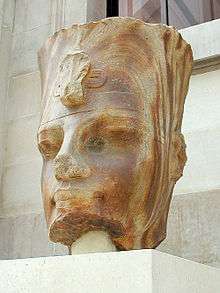 Great Court – Colossal quartzite statue of Amenhotep III, c. 1350 BC
Great Court – Colossal quartzite statue of Amenhotep III, c. 1350 BC- Room 4 - Limestone statue of a husband and wife, 1300-1250 BC
.jpg) Room 63 - Gilded outer coffins from the tomb of Henutmehyt, Thebes, Egypt, 19th Dynasty, 1250 BC
Room 63 - Gilded outer coffins from the tomb of Henutmehyt, Thebes, Egypt, 19th Dynasty, 1250 BC Book of the Dead of Hunefer, sheet 5, 19th Dynasty, 1250 BC
Book of the Dead of Hunefer, sheet 5, 19th Dynasty, 1250 BC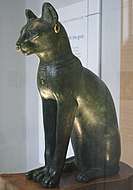 Room 4 - Ancient Egyptian bronze statue of a cat from the Late Period, about 664–332 BC
Room 4 - Ancient Egyptian bronze statue of a cat from the Late Period, about 664–332 BC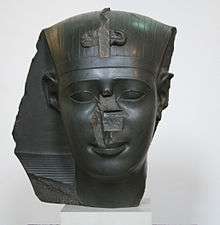 Room 4 - Green siltstone head of a Pharaoh, 26th-30th Dynasty, 600-340 BC
Room 4 - Green siltstone head of a Pharaoh, 26th-30th Dynasty, 600-340 BC Great Court - Black siltstone obelisk of King Nectanebo II of Egypt, Thirtieth dynasty, about 350 BC
Great Court - Black siltstone obelisk of King Nectanebo II of Egypt, Thirtieth dynasty, about 350 BC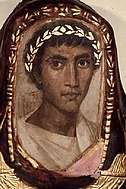 Room 62 - Detail from the mummy case of Artemidorus the Younger, a Greek who had settled in Thebes, Egypt, during Roman times, 100-200 AD
Room 62 - Detail from the mummy case of Artemidorus the Younger, a Greek who had settled in Thebes, Egypt, during Roman times, 100-200 AD
Department of Greece and Rome


The British Museum has one of the world's largest and most comprehensive collections of antiquities from the Classical world, with over 100,000 objects.[70] These mostly range in date from the beginning of the Greek Bronze Age (about 3200 BC) to the establishment of Christianity as the official religion of the Roman Empire, with the Edict of Milan under the reign of the Roman Emperor Constantine I in 313 AD. Archaeology was in its infancy during the nineteenth century and many pioneering individuals began excavating sites across the Classical world, chief among them for the museum were Charles Newton, John Turtle Wood, Robert Murdoch Smith and Charles Fellows.
The Greek objects originate from across the Ancient Greek world, from the mainland of Greece and the Aegean Islands, to neighbouring lands in Asia Minor and Egypt in the eastern Mediterranean and as far as the western lands of Magna Graecia that include Sicily and southern Italy. The Cycladic, Minoan and Mycenaean cultures are represented, and the Greek collection includes important sculpture from the Parthenon in Athens, as well as elements of two of the Seven Wonders of the Ancient World, the Mausoleum at Halicarnassus and the Temple of Artemis at Ephesos.[70]
Beginning from the early Bronze Age, the department also houses one of the widest-ranging collections of Italic and Etruscan antiquities outside Italy, as well as extensive groups of material from Cyprus and non-Greek colonies in Lycia and Caria on Asia Minor. There is some material from the Roman Republic, but the collection's strength is in its comprehensive array of objects from across the Roman Empire, with the exception of Britain (which is the mainstay of the Department of Prehistory and Europe).
The collections of ancient jewellery and bronzes, Greek vases (many from graves in southern Italy that were once part of Sir William Hamilton's and Chevalier Durand's collections), Roman glass including the famous Cameo glass Portland Vase, Roman mosaics from Carthage and Utica in North Africa that were excavated by Nathan Davis, and silver hoards from Roman Gaul (some of which were bequeathed by the philanthropist and museum trustee Richard Payne Knight), are particularly important. Cypriot antiquities are strong too and have benefited from the purchase of Sir Robert Hamilton Lang's collection as well as the bequest of Emma Turner in 1892, which funded many excavations on the island. Roman sculptures (many of which are copies of Greek originals) are particularly well represented by the Townley collection as well as residual sculptures from the famous Farnese collection.
Objects from the Department of Greece and Rome are located throughout the museum, although many of the architectural monuments are to be found on the ground floor, with connecting galleries from Gallery 5 to Gallery 23. On the upper floor, there are galleries devoted to smaller material from ancient Italy, Greece, Cyprus and the Roman Empire.
Key highlights of the collections include:
- The Parthenon Marbles (Elgin Marbles), (447–438 BC)
- A surviving column, (420–415 BC)
- One of six remaining Caryatids, (415 BC)
Temple of Athena Nike
- Surviving frieze slabs, (427–424 BC)
Temple of Bassae
- Twenty-three surviving blocks of the frieze from the interior of the temple, (420–400 BC)
- Two colossal free-standing figures identified as Maussollos and his wife Artemisia, (c. 350 BC)
- Part of an impressive horse from the chariot group adorning the summit of the Mausoleum, (c. 350 BC)
- The Amazonomachy frieze – A long section of relief frieze showing the battle between Greeks and Amazons, (c. 350 BC)
Temple of Artemis in Ephesus
- One of the sculptured column bases, (340–320 BC)
- Part of the Ionic frieze situated above the colonnade, (330–300 BC)
Knidos in Asia Minor
- Demeter of Knidos, (350 BC)
- Lion of Knidos, (350–200 BC)
Xanthos in Asia Minor
- Lion Tomb, (550–500 BC)
- Harpy Tomb, (480–470 BC)
- Nereid Monument, partial reconstruction of a large and elaborate Lykian tomb, (390–380 BC)
- Tomb of Merehi, (390–350 BC)
- Tomb of Payava, (375–350 BC)
Wider collection
Prehistoric Greece and Italy (3300 BC – 8th century BC)
- Over thirty Cycladic figures from islands in the Aegean Sea, many collected by James Theodore Bent, Greece, (3300–2000 BC)
- Material from the Palace of Knossos including a huge pottery storage jar, some donated by Sir Arthur Evans, Crete, Greece, (1900–1100 BC)
- The Minoan gold treasure from Aegina, northern Aegean, Greece, (1850–1550 BC)
- Segments of the columns and architraves from the Treasury of Atreus, Peloponnese, Greece, (1350–1250 BC)
- Elgin Amphora, highly decorated pottery vase attributed to the Dipylon Master, Athens, Greece, (8th century BC)
- Bronze Statuette of Athletic Spartan Girl
Etruscan (8th century BC – 1st century BC)
- Some of the artefacts from the Castellani Tomb in Palestrina, central Italy, (8th–6th century BC)
- Contents of the Isis Tomb, Vulci, (570–560 BC)
- Painted terracotta plaques (the so-called Boccanera Plaques) from a tomb in Cerveteri, (560–550 BC)
- Oscan Tablet, one of the most important inscriptions in the Oscan language, (300–100 BC)
- Sarcophagus of Seianti Hanunia Tlesnasa from Chiusi, (150–140 BC)
Ancient Greece (8th century BC – 4th century AD)
- Group of life-size archaic statues from the Sacred Way at Didyma, western Turkey, (600–580 BC)
- Dedicatory Inscription by Alexander the Great from Priene in Turkey (330 BC)
- Head from the colossal statue of the Asclepius of Milos, Greece, (325–300 BC)
- Bronze sculpture of a Greek poet known as the Arundel Head, western Turkey, (2nd–1st centuries BC)
- Remains of the Scylla monument at Bargylia, south west Anatolia, Turkey, (200–150 BC)
Ancient Rome (1st century BC – 4th century AD)
- Cameo glass Portland Vase, the most famous glass vessel from ancient Rome, (1–25 AD)
- Silver Warren Cup with homoerotic scenes, found near Jerusalem, (5–15 AD)
- Discus-thrower (Discobolos)[71] and Bronze Head of Hypnos from Civitella d'Arna, Italy, (1st–2nd centuries AD)
- Capitals from some of the pilasters of the Pantheon, Rome, (126 AD)
- Jennings Dog, a statue of a Molossian guard dog, central Italy, (2nd century AD)
 Room 12 – A gold earring from the Aegina Treasure, Greece, 1700-1500 BC
Room 12 – A gold earring from the Aegina Treasure, Greece, 1700-1500 BC- Room 18 – Parthenon statuary from the east pediment and Metopes from the south wall, Athens, Greece, 447-438 BC
.jpg)
 Room 20 – Tomb of Payava, Lycia, Turkey, 360 BC
Room 20 – Tomb of Payava, Lycia, Turkey, 360 BC.jpg) Room 21 – Fragmentary horse from the colossal chariot group which topped the podium of the Mausoleum at Halicarnassus, one of the Seven Wonders of the Ancient World, Turkey, c. 350 BC
Room 21 – Fragmentary horse from the colossal chariot group which topped the podium of the Mausoleum at Halicarnassus, one of the Seven Wonders of the Ancient World, Turkey, c. 350 BC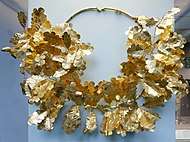 Room 22 - Gold oak wreath with a bee and two cicadas, western Turkey, c. 350-300 BC
Room 22 - Gold oak wreath with a bee and two cicadas, western Turkey, c. 350-300 BC- Room 22 – Column from the Temple of Artemis in Ephesus, one of the Seven Wonders of the Ancient World, Turkey, early 4th century BC
 Room 22 - Colossal head of Asclepius wearing a metal crown (now lost), from a cult statue on Melos, Greece, 325-300 BC
Room 22 - Colossal head of Asclepius wearing a metal crown (now lost), from a cult statue on Melos, Greece, 325-300 BC- Room 1 - Farnese Hermes in the Enlightenment Gallery, Italy, 1st century AD
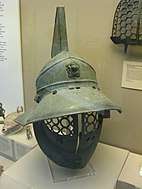 Room 69 - Roman gladiator helmet from Pompeii, Italy, 1st century AD
Room 69 - Roman gladiator helmet from Pompeii, Italy, 1st century AD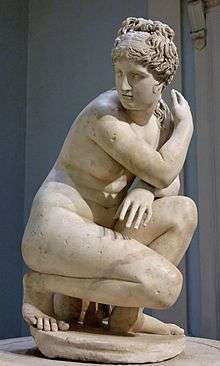 Room 23 - The famous version of the 'Crouching Venus', Roman, c. 1st century AD
Room 23 - The famous version of the 'Crouching Venus', Roman, c. 1st century AD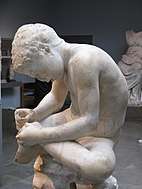 Room 22 – Roman marble copy of the famous 'Spinario (Boy with Thorn)', Italy, c. 1st century AD
Room 22 – Roman marble copy of the famous 'Spinario (Boy with Thorn)', Italy, c. 1st century AD Room 22 – Apollo of Cyrene (holding a lyre), Libya, c. 2nd century AD
Room 22 – Apollo of Cyrene (holding a lyre), Libya, c. 2nd century AD
Department of the Middle East
With a collection numbering some 330,000 works,[72] the British Museum possesses the world's largest and most important collection of Mesopotamian antiquities outside Iraq. A collection of immense importance, the holdings of Assyrian sculpture, Babylonian and Sumerian antiquities are among the most comprehensive in the world with entire suites of rooms panelled in alabaster Assyrian palace reliefs from Nimrud, Nineveh and Khorsabad.
The collections represent the civilisations of the ancient Near East and its adjacent areas. These cover Mesopotamia, Persia, the Arabian Peninsula, Anatolia, the Caucasus, parts of Central Asia, Syria, the Holy Land and Phoenician settlements in the western Mediterranean from the prehistoric period and include objects from the beginning of Islam in the 7th century.
The first significant addition of Mesopotamian objects was from the collection of Claudius James Rich in 1825. The collection was later dramatically enlarged by the excavations of A. H. Layard at the Assyrian sites of Nimrud and Nineveh between 1845 and 1851. At Nimrud, Layard discovered the North-West Palace of Ashurnasirpal II, as well as three other palaces and various temples. He later uncovered the Palace of Sennacherib at Nineveh with 'no less than seventy-one halls'. As a result, a large numbers of Lamassu's, palace reliefs, stelae, including the Black Obelisk of Shalmaneser III, were brought to the British Museum.
_~_Assyrian_Empire_%2B_Lamassu%2C_Gates_at_Balawat%2C_Relief_Panel's_%26_Full_Projection.3.jpg)
Layard's work was continued by his assistant, Hormuzd Rassam and in 1852–1854 he went on to discover the North Palace of Ashurbanipal at Nineveh with many magnificent reliefs, including the famous Lion Hunt of Ashurbanipal and Lachish reliefs. He also discovered the Royal Library of Ashurbanipal, a large collection of cuneiform tablets of enormous importance that today number around 130,000 pieces. W. K. Loftus excavated in Nimrud between 1850 and 1855 and found a remarkable hoard of ivories in the Burnt Palace. Between 1878 and 1882 Rassam greatly improved the museum's holdings with exquisite objects including the Cyrus Cylinder from Babylon, the bronze gates from Balawat, important objects from Sippar, and a fine collection of Urartian bronzes from Toprakkale.
In the early 20th century excavations were carried out at Carchemish, Turkey by D. G. Hogarth and Leonard Woolley, the latter assisted by T. E. Lawrence. The Mesopotamian collections were greatly augmented by excavations in southern Iraq after the First World War. From Tell al-Ubaid came the bronze furnishings of a Sumerian temple, including life-sized lions and a panel featuring the lion-headed eagle Indugud found by H. R. Hall in 1919–24. Woolley went on to excavate Ur between 1922 and 1934, discovering the 'Royal Cemeteries' of the 3rd millennium BC. Some of the masterpieces include the 'Standard of Ur', the 'Ram in a Thicket', the 'Royal Game of Ur', and two bull-headed lyres. The department also has three diorite statues of the ruler Gudea from the ancient state of Lagash and a series of limestone kudurru or boundary stones from different locations across ancient Mesopotamia.
Although the collections centre on Mesopotamia, most of the surrounding areas are well represented. The Achaemenid collection was enhanced with the addition of the Oxus Treasure in 1897 and objects excavated by the German scholar Ernst Herzfeld and the Hungarian-British explorer Sir Aurel Stein. Reliefs and sculptures from the site of Persepolis were donated by Sir Gore Ouseley in 1825 and the 5th Earl of Aberdeen in 1861. Moreover, the museum has been able to acquire one of the greatest assemblages of Achaemenid silverware in the world. The later Sasanian Empire is also well represented by ornate silver plates and cups, many representing ruling monarchs hunting lions and deer. Phoenician antiquities come from across the region, but the Tharros collection from Sardinia and the large number of Phoenician stelae from Carthage are outstanding. Another often overlooked highlight is Yemeni antiquities, the finest collection outside that country. Furthermore, the museum has a representative collection of Dilmun and Parthian material excavated from various burial mounds at the ancient sites of A'ali and Shakhura in Bahrain.
From the modern state of Syria come almost forty funerary busts from Palmyra and a group of stone reliefs from the excavations of Max von Oppenheim at Tell Halaf that was purchased in 1920. More material followed from the excavations of Max Mallowan at Chagar Bazar and Tell Brak in 1935–1938 and from Woolley at Alalakh in the years just before and after the Second World War. Mallowan returned with his wife Agatha Christie to carry out further digs at Nimrud in the postwar period which secured many important artefacts for the museum. The collection of Palestinian material was strengthened by the work of Kathleen Kenyon at Tell es-Sultan (Jericho) in the 1950s and the acquisition in 1980 of around 17,000 objects found at Lachish by the Wellcome-Marston expedition of 1932–1938. Archaeological digs are still taking place where permitted in the Middle East, and, depending on the country, the museum continues to receive a share of the finds from sites such as Tell es Sa'idiyeh in Jordan.
The museum's collection of Islamic art, including archaeological material, numbers about 40,000 objects,[73] one of the largest of its kind in the world. As such, it contains a broad range of pottery, paintings, tiles, metalwork, glass, seals, and inscriptions from across the Islamic world, from Spain in the west to India in the east. It is particularly famous for its collection of Iznik ceramics (the largest in the world), a highlight of which is the mosque lamp from the Dome of the Rock, mediaeval metalwork such as the Vaso Vescovali with its depictions of the Zodiac, a fine selection of astrolabes, and Mughal paintings and precious artwork including a large jade terrapin made for the Emperor Jahangir. Thousands of objects were excavated after the war by professional archaeologists at Iranian sites such as Siraf by David Whitehouse and Alamut Castle by Peter Willey. The collection was augmented in 1983 by the Godman bequest of Iznik, Hispano-Moresque and early Iranian pottery. Artefacts from the Islamic world are on display in Gallery 34 of the museum.
A representative selection from the Department of Middle East, including the most important pieces, are on display in 13 galleries throughout the museum and total some 4,500 objects. A whole suite of rooms on the ground floor display the sculptured reliefs from the Assyrian palaces at Nineveh, Nimrud and Khorsabad, while 8 galleries on the upper floor hold smaller material from ancient sites across the Middle East. The remainder form the study collection which ranges in size from beads to large sculptures. They include approximately 130,000 cuneiform tablets from Mesopotamia.[74]
Key highlights of the collections include:
|
Assyrian palace reliefs from:
|
Sculptures:
|
|
Assyrian palace reliefs and sculptures from:
|
Royal Library of Ashurbanipal:
|
|
|
- Wider collection:
- Plastered human skull from Jericho, a very early form of portraiture, Palestine, (7000–6000 BC)
- Tell Brak Head, one of the oldest portrait busts from the Middle East, north east Syria, (3500–3300 BC)
- Uruk Trough, one of the earliest surviving works of narrative relief sculpture from the Middle East, southern Iraq, (3300–3000 BC)
- Statue of Idrimi from the ancient city of Alalakh, southern Turkey, (1600 BC)
- A fine collection of Urartian bronzes, which now form the core of the Anatolian collection, eastern Turkey, (9th–6th centuries BC)
- Tablet of Shamash, depicting the sun-god Shamash, from Sippar, Iraq, (early 9th century BC)
- Two large Assyrian stelae from Kurkh, southern Turkey, (850 BC)
- Shebna Inscription from Siloam near Jerusalem, Israel, (7th century BC)
- East India House Inscription from Babylon, Iraq, (604–562 BC)
- Lachish Letters, group of ostraka written in alphabetic Hebrew from Lachish, Israel, (586 BC)
- Cylinder of Nabonidus, foundation cylinder of King Nabonidus, Sippar, Iraq, (555–540 BC)
- The famous Oxus Treasure, the largest ancient Persian hoard of gold artefacts, (550–330 BC)
- The Punic-Libyan Inscription from the Mausoleum of Ateban, Dougga, Tunisia, (146 BC)
- Amran Tablets found near Sana'a, Yemen, (1st century BC)
- Two limestone ossuaries from caves in Jerusalem, (1st century AD)
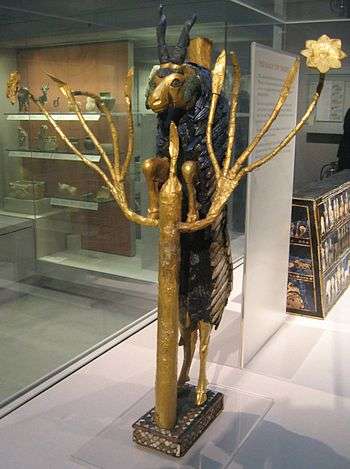 Room 56 – The 'Ram in a Thicket' figure, one of a pair, from Ur, Southern Iraq, c. 2600 BC
Room 56 – The 'Ram in a Thicket' figure, one of a pair, from Ur, Southern Iraq, c. 2600 BC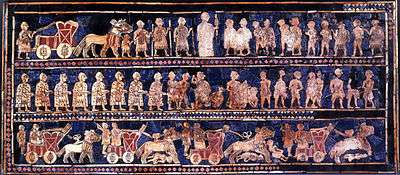 Room 56 – The famous 'Standard of Ur', a hollow wooden box with scenes of war and peace, from Ur, c. 2600 BC
Room 56 – The famous 'Standard of Ur', a hollow wooden box with scenes of war and peace, from Ur, c. 2600 BC Room 56 - Sculpture of the god Imdugud, lion-headed eagle surmounting a lintel made from sheets of copper, Temple of Ninhursag at Tell al-'Ubaid, Iraq, c. 2500 BC
Room 56 - Sculpture of the god Imdugud, lion-headed eagle surmounting a lintel made from sheets of copper, Temple of Ninhursag at Tell al-'Ubaid, Iraq, c. 2500 BC Room 56 - Statue of Kurlil, from the Temple of Ninhursag in Tell al-'Ubaid, southern Iraq, c. 2500 BC
Room 56 - Statue of Kurlil, from the Temple of Ninhursag in Tell al-'Ubaid, southern Iraq, c. 2500 BC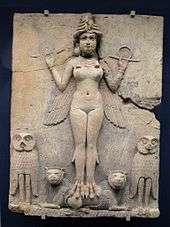 Room 56 – The famous Babylonian 'Queen of the Night relief' of the goddess Ishtar, Iraq, c. 1790 BC
Room 56 – The famous Babylonian 'Queen of the Night relief' of the goddess Ishtar, Iraq, c. 1790 BC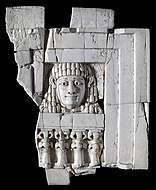 Room 57 - Carved ivory object from the Nimrud Ivories, Phoenician, Nimrud, Iraq, 9th–8th century BC
Room 57 - Carved ivory object from the Nimrud Ivories, Phoenician, Nimrud, Iraq, 9th–8th century BC Room 6 – Depiction of the hypocrite, Jehu, King of Israel on the Black Obelisk of Shalmaneser III, Nimrud, c. 827 BC
Room 6 – Depiction of the hypocrite, Jehu, King of Israel on the Black Obelisk of Shalmaneser III, Nimrud, c. 827 BC- Room 10 – Human Headed Winged Bulls from Khorsabad, companion pieces in the Musée du Louvre, Iraq, 710–705 BC
- Room 55 – Cuneiform Collection, including the Epic of Gilgamesh, Iraq, c. 669-631 BC
 Room 55 – Lion Hunt of Ashurbanipal (detail), Nineveh, Neo-Assyrian, Iraq, c. 645 BC
Room 55 – Lion Hunt of Ashurbanipal (detail), Nineveh, Neo-Assyrian, Iraq, c. 645 BC- Room 55 - Panel with striding lion made from glazed bricks, Neo-Babylonian, Nebuchadnezzar II, Southern Iraq, 604–562 BC
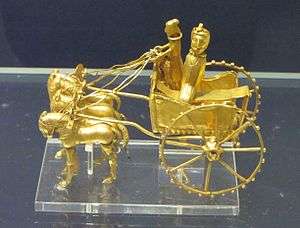 Room 52 – A chariot from the Oxus Treasure, the most important surviving collection of Achaemenid Persian metalwork, c. 5th to 4th centuries BC
Room 52 – A chariot from the Oxus Treasure, the most important surviving collection of Achaemenid Persian metalwork, c. 5th to 4th centuries BC Room 53 - Stela said to come from Tamma' cemetery, Yemen, 1st century AD
Room 53 - Stela said to come from Tamma' cemetery, Yemen, 1st century AD Room 53 - Alabaster statue of a standing female figure, Yemen, 1st-2nd centuries AD
Room 53 - Alabaster statue of a standing female figure, Yemen, 1st-2nd centuries AD Room 34 - Cylindrical lidded box with an Arabic inscription recording its manufacture for the ruler of Mosul, Badr al-Din Lu'lu', Iraq, c. 1233 – 1259 AD
Room 34 - Cylindrical lidded box with an Arabic inscription recording its manufacture for the ruler of Mosul, Badr al-Din Lu'lu', Iraq, c. 1233 – 1259 AD
Department of Prints and Drawings
The Department of Prints and Drawings holds the national collection of Western prints and drawings. It ranks as one of the largest and best print room collections in existence alongside the Albertina in Vienna, the Paris collections and the Hermitage. The holdings are easily accessible to the general public in the Study Room, unlike many such collections.[75] The department also has its own exhibition gallery in Room 90, where the displays and exhibitions change several times a year.[76]
Since its foundation in 1808, the prints and drawings collection has grown to international renown as one of the richest and most representative collections in the world. There are approximately 50,000 drawings and over two million prints.[76] The collection of drawings covers the period from the 14th century to the present, and includes many works of the highest quality by the leading artists of the European schools. The collection of prints covers the tradition of fine printmaking from its beginnings in the 15th century up to the present, with near complete holdings of most of the great names before the 19th century. Key benefactors to the department have been Clayton Mordaunt Cracherode, Richard Payne Knight, John Malcolm, Campbell Dodgson, César Mange de Hauke and Tomás Harris.
There are groups of drawings by Leonardo da Vinci, Raphael, Michelangelo, (including his only surviving full-scale cartoon), Dürer (a collection of 138 drawings is one of the finest in existence), Peter Paul Rubens, Rembrandt, Claude and Watteau, and largely complete collections of the works of all the great printmakers including Dürer (99 engravings, 6 etchings and most of his 346 woodcuts), Rembrandt and Goya. More than 30,000 British drawings and watercolours include important examples of work by Hogarth, Sandby, Turner, Girtin, Constable, Cotman, Cox, Gillray, Rowlandson and Cruikshank, as well as all the great Victorians. There are about a million British prints including more than 20,000 satires and outstanding collections of works by William Blake and Thomas Bewick.. The great eleven volume Catalogue of Political and Personal Satires Preserved in the Department of Prints and Drawings in the British Museum compiled between 1870 and 1954 is the definitive reference work for the study of British Satirical prints. Over 500,000 objects from the department are now on the online collection database, many with high-quality images.[77] A 2011 donation of £1 million enabled the museum to acquire a complete set of Pablo Picasso's Vollard Suite.[78]
 Rogier van der Weyden - Portrait of a Young Woman, c. 1440
Rogier van der Weyden - Portrait of a Young Woman, c. 1440 Hieronymus Bosch - A comical barber scene, c. 1477-1516
Hieronymus Bosch - A comical barber scene, c. 1477-1516 Sandro Botticelli - Allegory of Abundance, 1480-1485
Sandro Botticelli - Allegory of Abundance, 1480-1485 Leonardo da Vinci – The Virgin and Child with Saint Anne and the Infant Saint John the Baptist (prep for 'The Burlington House Cartoon'), c. 1499–1500
Leonardo da Vinci – The Virgin and Child with Saint Anne and the Infant Saint John the Baptist (prep for 'The Burlington House Cartoon'), c. 1499–1500 Michelangelo – Studies of a reclining male nude: Adam in the fresco 'The Creation of Man' on the vault of the Sistine Chapel, c. 1511
Michelangelo – Studies of a reclining male nude: Adam in the fresco 'The Creation of Man' on the vault of the Sistine Chapel, c. 1511 Raphael – Study of Heads, Mother and Child, c. 1509-11
Raphael – Study of Heads, Mother and Child, c. 1509-11
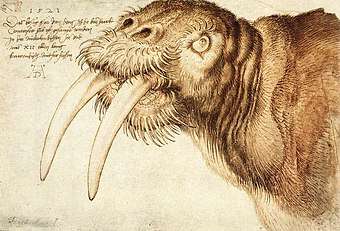 Albrecht Dürer - Drawing of a walrus, 1521
Albrecht Dürer - Drawing of a walrus, 1521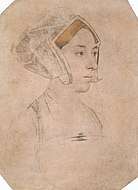 Hans Holbein the Younger - Portrait of Anne Boleyn, 1536
Hans Holbein the Younger - Portrait of Anne Boleyn, 1536 Peter Paul Rubens - Drawing of a lioness, c. 1614-1615
Peter Paul Rubens - Drawing of a lioness, c. 1614-1615 Francisco de Zurbarán - Head of a monk, 1625–64
Francisco de Zurbarán - Head of a monk, 1625–64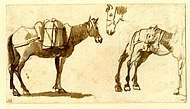 Claude Lorrain - Drawing of mules, including one full-length, 1630-1640
Claude Lorrain - Drawing of mules, including one full-length, 1630-1640
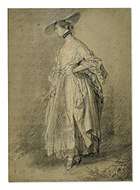 Thomas Gainsborough - Drawing of a woman with a rose, 1763-1765
Thomas Gainsborough - Drawing of a woman with a rose, 1763-1765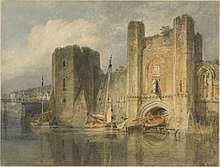 JMW Turner - Watercolour of Newport Castle, 1796
JMW Turner - Watercolour of Newport Castle, 1796 Isaac Cruikshank - 'The happy effects of that grand system of shutting ports against the English!!', 1808
Isaac Cruikshank - 'The happy effects of that grand system of shutting ports against the English!!', 1808 John Constable - London from Hampstead Heath in a Storm, (watercolour), 1831
John Constable - London from Hampstead Heath in a Storm, (watercolour), 1831 James McNeill Whistler - View of the Battersea side of Chelsea Reach, London, (lithograph), 1878
James McNeill Whistler - View of the Battersea side of Chelsea Reach, London, (lithograph), 1878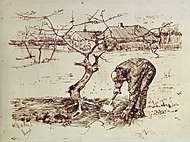 Vincent Van Gogh - Man Digging in the Orchard (print), 1883
Vincent Van Gogh - Man Digging in the Orchard (print), 1883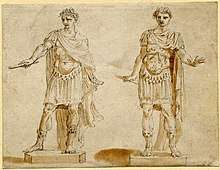 Peter van Dievoet - Studies for a statue of a figure in Roman dress, most likely for the statue of James II.[79]
Peter van Dievoet - Studies for a statue of a figure in Roman dress, most likely for the statue of James II.[79]
Department of Britain, Europe and Prehistory
The Department of Britain, Europe and Prehistory is responsible for collections that cover a vast expanse of time and geography. It includes some of the earliest objects made by humans in east Africa over 2 million years ago, as well as Prehistoric and neolithic objects from other parts of the world; and the art and archaeology of Europe from the earliest times to the present day. Archeological excavation of prehistoric material took off and expanded considerably in the twentieth century and the department now has literally millions of objects from the Paleolithic and Mesolithic periods throughout the world, as well as from the Neolithic, Bronze Age and Iron Age in Europe. Stone Age material from Africa has been donated by famous archaeologists such as Louis and Mary Leakey, and Gertrude Caton–Thompson. Paleolithic objects from the Sturge, Christy and Lartet collections include some of the earliest works of art from Europe. Many Bronze Age objects from across Europe were added during the nineteenth century, often from large collections built up by excavators and scholars such as Greenwell in Britain, Tobin and Cooke in Ireland, Lukis and de la Grancière in Brittany, Worsaae in Denmark, Siret at El Argar in Spain, and Klemm and Edelmann in Germany. A representative selection of Iron Age artefacts from Hallstatt were acquired as a result of the Evans/Lubbock excavations and from Giubiasco in Ticino through the Swiss National Museum.
In addition, the British Museum's collections covering the period AD 300 to 1100 are among the largest and most comprehensive in the world, extending from Spain to the Black Sea and from North Africa to Scandinavia; a representative selection of these has recently been redisplayed in a newly refurbished gallery. Important collections include Latvian, Norwegian, Gotlandic and Merovingian material from Johann Karl Bähr, Alfred Heneage Cocks, Sir James Curle and Philippe Delamain respectively. However, the undoubted highlight from the early mediaeval period are the magnificent items from the Sutton Hoo royal grave, generously donated to the nation by the landowner Edith Pretty. The department includes the national collection of horology with one of the most wide-ranging assemblage of clocks, watches and other timepieces in Europe, with masterpieces from every period in the development of time-keeping. Choice horological pieces came from the Morgan and Ilbert collections. The department is also responsible for the curation of Romano-British objects – the museum has by far the most extensive such collection in Britain and one of the most representative regional collections in Europe outside Italy. It is particularly famous for the large number of late Roman silver treasures, many of which were found in East Anglia, the most important of which is the Mildenhall Treasure. The museum purchased many Roman-British objects from the antiquarian Charles Roach Smith in 1856. These quickly formed the nucleus of the collection.
Objects from the Department of Prehistory and Europe are mostly found on the upper floor of the museum, with a suite of galleries numbered from 38 to 51. Most of the collection is stored in its archive facilities, where it is available for research and study.
Key highlights of the collections include:
Stone Age (c. 3.4 million years BC – c. 2000 BC)
- Palaeolithic material from across Africa, particularly Olduvai, Kalambo Falls, Olorgesailie and Cape Flats, (1.8 million BC onwards)
- One of the 11 leaf-shaped points found near Volgu, Saône-et-Loire, France and estimated to be 16,000 years old[80]
- Ice Age art from France including the Wolverine pendant of Les Eyzies, Montastruc decorated stone and Baton fragment, (c. 12–11,000 BC)
- Ice Age art from Britain including the decorated jaw from Kendrick and Robin Hood Cave Horse, (11,500–10,000 BC)
- Rare mesolithic artefacts from the site of Star Carr in Yorkshire, northern England, (8770–8460 BC)
- Terracotta figurine from Vinča, Serbia, (5200–4900 BC)
- Callaïs bead jewellery from Lannec-er-Ro'h and triangular pendant from Mané-er-Hroëk, Morbihan, Brittany, western France, (4700–4300 BC)
- Section of the Sweet Track, an ancient timber causeway from the Somerset Levels, England, (3807/6 BC)
- A number of Carved Stone Balls from Scotland, Ireland and northern England, (3200–2500 BC)
- The three Folkton Drums, made from chalk and found in Yorkshire, northern England, (2600–2100 BC)
Bronze Age (c. 3300 BC – c. 600 BC)
- Jet beaded necklace from Melfort in Argyll, Scotland, (c. 3000 BC)
- Gold lunula from Blessington, Ireland, one of nine from Ireland, Wales and Cornwall, (2400–2000 BC)
- Early Bronze Age hoards from Snowshill, Driffield and Barnack in England, Arraiolos and Vendas Novas in Iberia and Neunheilingen and Biecz in central Europe (2280–1500 BC)
- Contents of the Rillaton Barrow including a gold cup, and the related Ringlemere Cup, England, (1700–1500 BC)
- Bronze Age hoards from Zsujta, Forró and Paks-Dunaföldvár in Hungary, (1600–1000 BC)
- Large ceremonial swords or dirks from Oxborough and Beaune, western Europe, (1450–1300 BC)
- Bronze shields from Moel Hebog and Rhyd-y-gors, Wales, (12th–10th centuries BC)
- Gold hoards from Morvah and Towednack in Cornwall, Milton Keynes in Buckinghamshire and Mooghaun in Ireland, (1150–750 BC)
- Dunaverney flesh-hook found near Ballymoney, Northern Ireland and part of the Dowris Hoard from County Offaly, Ireland, (1050–900 BC & 900–600 BC)
- Late Bronze Age gold hoard from Abia de la Obispalía, Spain and an intricate gold collar from Sintra, Portugal, (10th–8th centuries BC)
Iron Age (c. 600 BC – c. 1st century AD)
- Basse Yutz Flagons, a pair of bronze drinking vessels from Moselle, eastern France, (5th century BC)
- Morel collection of La Tène material from eastern France, including the Somme-Bionne chariot burial and the Prunay Vase, (450-300BC)
- Important finds from the River Thames including the Wandsworth Shield, Battersea Shield and Waterloo Helmet, as well as the Witham Shield from Lincolnshire, eastern England, (350–50 BC)
- Pair of gold collars called the Orense Torcs from northwest Spain, (300–150 BC)
- Other gold neck collars including the Ipswich Hoard and the Sedgeford Torc, England, (200–50 BC)
- Winchester Hoard of gold jewellery from southern England and the Great Torc from Snettisham in Norfolk, East Anglia, (100 BC)
- Cordoba and Arcillera Treasures, two silver Celtic hoards from Spain, (100–20 BC)
- Lindow Man found by accident in a peat bog in Cheshire, England, (1st century AD)
- Stanwick Hoard of horse and chariot fittings and the Meyrick Helmet, northern England, (1st century AD)
- Lochar Moss Torc and two massive pairs of bronze armlets from Muthill and Strathdon, Scotland, (50–200 AD)
Romano-British (43 AD – 410 AD)
- Tombstone of Roman procurator Gaius Julius Alpinus Classicianus from London, (1st century)
- Ribchester, Guisborough and Witcham helmets once worn by Roman cavalry in Britain, (1st–2nd centuries)
- Elaborate gold bracelets and ring found near Rhayader, central Wales, (1st–2nd centuries)
- Bronze heads of the Roman Emperors Hadrian and Claudius, found in London and Suffolk, (1st–2nd centuries)
- Vindolanda Tablets, important historical documents found near Hadrian's Wall in Northumberland, (1st–2nd centuries)
- Wall-paintings and sculptures from the Roman Villa at Lullingstone, Kent, south east England, 1st–4th centuries)
- Capheaton and Backworth treasures, remnants of two important hoards from northern England, (2nd–3rd centuries)
- Stony Stratford Hoard of copper headdresses, fibulae and silver votive plaques, central England, (3rd century)
- Gold jewellery deposited at the site of Newgrange, Ireland, (4th century)
- Thetford Hoard, late Roman jewellery from eastern England, (4th century)
Early Mediaeval (c. 4th century AD – c. 1000 AD)
- Part of the Asyut, Domagnano, Artres, Sutri, Bergamo and Belluno Treasures, (4th–7th centuries)
- Lycurgus Cup, a unique figurative glass cage cup, and the Byzantine Archangel ivory panel, (4th–6th centuries)
- The Sutton Hoo treasure and Taplow burial, with some of the greatest finds from the early Middle Ages in Europe, England, (6th–7th centuries)
- Two Viking hoards from Norway known as the Lilleberge Viking Burial and Tromsø Burial and the Cuerdale Hoard from England, (7th–10th centuries)
- Irish reliquaries such as the Kells Crozier and Bell Shrine of St. Cuileáin, (7th–11th centuries)
- Early Anglo Saxon Franks Casket, a unique ivory container from northern England, (8th century)
- A number of important pseudo-penannular brooches including the Londesborough Brooch and the Breadalbane Brooch, Ireland and Scotland, (8th–9th centuries)
- Carolingian cut gems known as the Lothair Crystal and Saint-Denis Crystal, central Europe, (9th century)
- Anglo-Saxon Fuller and Strickland Brooches with their complex, niello-inlaid design, England, (9th century)
- Seax of Beagnoth, iron sword with long Anglo-Saxon Runic inscription, London, England, (10th century)
- The earlier of the River Witham swords
Mediaeval (c. 1000 AD – c. 1500 AD)
- A number of mediaeval ivory panels including the Borradaile, Wernher and John Grandisson Triptychs, (10th–14th centuries)
- The famous Lewis chessmen found in the Outer Hebrides, Scotland, (12th century)
- Reliquary of St. Eustace from the treasury of Basel Munster, Switzerland, (12th century)
- The unique Warwick Castle Citole, an early form of guitar, central England, (1280–1330)
- Savernake Horn, elephant ivory horn with silver gilt mounts, England and Scotland, (1325–1350)
- Asante Jug, mysteriously found at the Asante Court in the late 19th century, England, (1390–1400)
- Holy Thorn Reliquary bequeathed by Ferdinand de Rothschild as part of the Waddesdon Bequest, Paris, France, (14th century)
- Dunstable Swan Jewel, a gold and enamel brooch in the form of a swan, England, (14th century)
- A silver astrolabe quadrant from Canterbury, southeastern England, (14th century)
- Magnificent cups made from precious metal such as the Royal Gold Cup and the Lacock Cup, western Europe, (14th–15th centuries)
- The later of the River Witham swords
Renaissance to Modern (c. 1500 AD – present)
- The Armada Service, 26 silver dishes found in Devon, south west England, (late 16th to early 17th centuries)
- Early Renaissance Lyte Jewel, presented to Thomas Lyte of Lytes Cary, Somerset by King James I of England, (1610)
- Huguenot silver from the Peter Wilding bequest, England, (18th century)
- Pair of so-called Cleopatra Vases from the Chelsea porcelain factory, London, England, (1763)
- Jaspar ware vase known as the Pegasus Vase made by Josiah Wedgwood, England, (1786)
- Two of Charles Darwin's chronometers used on the voyage of HMS Beagle, (1795–1805)
- The Hull Grundy Gift of jewellery, Europe and North America, (19th century)
- Oak clock with mother-of-pearl engraving designed by Charles Rennie Mackintosh, (1919)
- Silver tea-infuser designed by Marianne Brandt from the Bauhaus art school, Germany, (1924)
- The Rosetta Vase, earthenware pottery vase designed by the contemporary British artist Grayson Perry, (2011)
The many hoards of treasure include those of Mildenhall, Esquiline, Carthage, First Cyprus, Lampsacus, Water Newton, Hoxne, and Vale of York (4th–10th centuries AD).

 Room 3 – Swimming Reindeer carving, France, c. 13,000 years BC[81]
Room 3 – Swimming Reindeer carving, France, c. 13,000 years BC[81]
 Room 51 – Mold gold cape, North Wales, Bronze Age, c. 1900–1600 BC
Room 51 – Mold gold cape, North Wales, Bronze Age, c. 1900–1600 BC Room 50 - Wandsworth Shield, Iron Age shield boss in La Tène style, England, 2nd century BC
Room 50 - Wandsworth Shield, Iron Age shield boss in La Tène style, England, 2nd century BC- Room 50 - Gold torc found in Needwood Forest, central England, 75 BC
 Room 49 - Bronze head of a Roman Emperor Claudius, from Rendham in Suffolk, eastern England, 1st century AD
Room 49 - Bronze head of a Roman Emperor Claudius, from Rendham in Suffolk, eastern England, 1st century AD Room 49 – Hinton St Mary Mosaic with face of Christ in the centre, from Dorset, southern England, 4th century AD
Room 49 – Hinton St Mary Mosaic with face of Christ in the centre, from Dorset, southern England, 4th century AD Room 49 - Corbridge Lanx, silver tray depicting a shrine to Apollo, northern England, 4th century AD
Room 49 - Corbridge Lanx, silver tray depicting a shrine to Apollo, northern England, 4th century AD Room 41 - Silver objects from the Roman Coleraine Hoard, Northern Ireland, 4th-5th centuries AD
Room 41 - Silver objects from the Roman Coleraine Hoard, Northern Ireland, 4th-5th centuries AD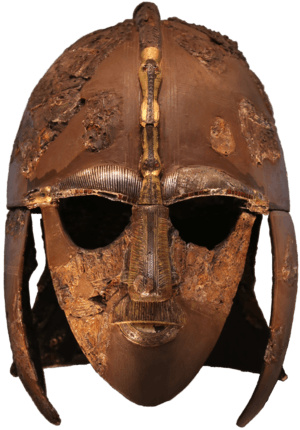 Room 41 – Sutton Hoo helmet, Anglo-Saxon, England, early 7th century AD
Room 41 – Sutton Hoo helmet, Anglo-Saxon, England, early 7th century AD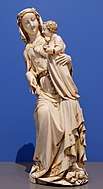 Room 40 - Ivory statue of Virgin and Child, who is crushing a dragon under her left foot from Paris, France, 1310-1330 AD
Room 40 - Ivory statue of Virgin and Child, who is crushing a dragon under her left foot from Paris, France, 1310-1330 AD Room 40 - Chaucer Astrolabe, the oldest dated in Europe, 1326 AD
Room 40 - Chaucer Astrolabe, the oldest dated in Europe, 1326 AD Room 40 – Royal Gold Cup or Saint Agnes Cup, made in Paris, France, 1370–80 AD
Room 40 – Royal Gold Cup or Saint Agnes Cup, made in Paris, France, 1370–80 AD Room 2a – Holy Thorn Reliquary, made in Paris, c. 1390s AD
Room 2a – Holy Thorn Reliquary, made in Paris, c. 1390s AD Room 38 – Mechanical Galleon clock, Augsburg, Germany, around 1585 AD
Room 38 – Mechanical Galleon clock, Augsburg, Germany, around 1585 AD Room 38 - Carillon clock with automata by Isaac Habrecht, Switzerland, 1589 AD
Room 38 - Carillon clock with automata by Isaac Habrecht, Switzerland, 1589 AD- Room 39 - Ornate clock made by Thomas Tompion, England, 1690 AD
Department of Asia
The scope of the Department of Asia is extremely broad; its collections of over 75,000 objects cover the material culture of the whole Asian continent (from East, South, Central and South-East Asia) and from the Neolithic up to the present day. Until recently, this department concentrated on collecting Oriental antiquities from urban or semi-urban societies across the Asian continent. Many of those objects were collected by colonial officers and explorers in former parts of the British Empire, especially the Indian subcontinent. Examples include the collections made by individuals such as Charles Stuart, James Prinsep, Charles Masson, Sir Alexander Cunningham, Sir Harold Deane and Sir John Marshall. A large number of Chinese antiquities were purchased from the Anglo-Greek banker George Eumorfopoulos in the 1930s. In the second half of the twentieth century, the museum greatly benefited from the bequest of the philanthropist PT Brooke Sewell, which allowed the department to purchase many objects and fill in gaps in the collection.[83][84][85]
In 2004, the ethnographic collections from Asia were transferred to the department. These reflect the diverse environment of the largest continent in the world and range from India to China, the Middle East to Japan. Much of the ethnographic material comes from objects originally owned by tribal cultures and hunter-gatherers, many of whose way of life has disappeared in the last century. Particularly valuable collections are from the Andaman and Nicobar Islands (much assembled by the British naval officer Maurice Portman), Sri Lanka (especially through the colonial administrator Hugh Nevill), Northern Thailand, south-west China, the Ainu of Hokaidu in Japan (chief among them the collection of the Scottish zoologist John Anderson), Siberia and the islands of South-East Asia, especially Borneo. The latter benefited from the purchase in 1905 of the Sarawak collection put together by Dr Charles Hose, as well as from other colonial officers such as Edward A Jeffreys. In addition, a unique and valuable group of objects from Java, including shadow puppets and a gamelan musical set, was assembled by Sir Stamford Raffles.
The principal gallery devoted to Asian art in the museum is Gallery 33 with its comprehensive display of Chinese, Indian subcontinent and Southeast Asian objects. An adjacent gallery showcases the Amaravati sculptures and monuments. Other galleries on the upper floors are devoted to its Japanese, Korean, painting and calligraphy, and Chinese ceramics collections.
Key highlights of the collections include:[86]
- The most comprehensive collection of sculpture from the Indian subcontinent in the world, including the celebrated Buddhist limestone reliefs from Amaravati excavated by Sir Walter Elliot[87]
- An outstanding collection of Chinese antiquities, paintings, and porcelain, lacquer, bronze, jade, and other applied arts
- The most comprehensive collection of Japanese pre-20th century art in the Western world, many of which originally belonged to the surgeon William Anderson and diplomat Ernest Mason Satow
East Asia
- A large collection of Chinese ritual bronzes, (from c. 1500 BC onwards)
- Huixian Bronze Hu, an identical pair of bronze vessels from the Eastern Zhou period, China, (5th century BC)
- Japanese antiquities from the Kofun period excavated by the pioneering archaeologist William Gowland, (3rd–6th centuries AD)
- The famous Admonitions Scroll by Chinese artist Gu Kaizhi, (344–406 AD)
- The colossal Amitābha Buddha from Hancui, China, (585 AD)
- A set of ceramic Tang dynasty tomb figures of Liu Tingxun, (c. 728 AD)
- Seated Luohan from Yixian, one from a set of eight surviving statues, China, (907–1125 AD)
- A fine assemblage of Buddhist paintings from Dunhuang, western China, collected by the British-Hungarian explorer Aurel Stein, (5th–11th centuries AD)
- Pericival David collection of Chinese ceramics, (10th–18th centuries AD)
- Ivory stand in the form of a seated lion, Chos-'khor-yan-rtse monastery in Tibet, (13th century AD)
- Pair of ceramic Kakiemon elephants from Japan, (17th century AD)
- Japanese prints including The Great Wave off Kanagawa, (1829–32)
South Asia
- Excavated objects from the Indus Valley sites of Mohenjo-daro, and Harappa, Ancient India (now in Pakistan), (2500–2000 BC)
- Sandstone fragment of a Pillar of Ashoka with Brahmi inscription from Meerut, Uttar Pradesh, India, (238 BC)
- The Kulu Vase found near a monastery in Himachal Pradesh, one of the earliest examples of figurative art from the sub-continent, northern India, (1st century BC)
- Copper plate from Taxila, with important Kharoshthi inscription, Ancient India (now in Pakistan), (1st century BC – 1st century AD)
- Indo-Scythian sandstone Mathura Lion Capital and Bracket figure from one of the gateways to the Great Stupa at Sanchi, central India, (1st century AD)
- Bimaran Casket and Wardak Vase, reliquaries from ancient stupas in Afghanistan, (1st–2nd centuries AD)
- Relic deposits from the stupas at Manikyala, Ahin Posh, Sanchi and Gudivada, (1st–3rd centuries AD)
- Seated Buddha from Gandhara, and other Gandhara objects from Kafir Kot, Jamal Garhi and Takht-i-Bahi, Pakistan, (1st–3rd centuries AD)
- The Buddhapad Hoard of bronze images from southern India, (6th–8th centuries AD)
- Stone statue of Buddha from the Sultanganj hoard, Bihar, eastern India. (7th–8th centuries AD)
- Statue of Tara from Sri Lanka and the Thanjavur Shiva from Tamil Nadu, southern India, (8th century & 10th century AD)
- Statue of the goddess Ambika found at Dhar in central India, (1034 AD)
- Sculpture of the two Jain tirthankaras Rishabhanatha and Mahavira, Orissa, India, 11th–12th century AD
South-east Asia
- Earthenware tazza from the Phùng Nguyên culture, northern Vietnam, (2000–1500 BC)
- Pottery vessels and sherds from the ancient site of Ban Chiang, Thailand, (10th–1st centuries BC)
- Bronze bell from Klang, Malaysia, (2nd century BC)
- Group of six Buddhist clay votive plaques found in a cave in Patania, Penang, Malaysia (6th–11th centuries AD)
- The famous Sambas Treasure of buddhist gold and silver figures from west Borneo, Indonesia, (8th–9th centuries AD)
- Two stone Buddha heads from the temple at Borobodur in Java, Indonesia, (9th century AD)
- Sandstone Champa figure of a rampant lion, Vietnam, (11th century AD)
- Stone figure representing the upper part of an eleven-headed Avalokiteśvara, Cambodia, (12th century AD)
- Bronze figure of a seated Buddha from Bagan, Burma, (12th–13th centuries AD)
- Hoard of Southern Song dynasty ceramic vessels excavated at Pinagbayanan, Taysan Municipality, Philippines, (12th–13th centuries AD)
- Statue of the Goddess Mamaki from Candi Jago, eastern Java, Indonesia, (13th–14th centuries AD)
- Inscribed bronze figure of a Buddha from Fang District, part of a large SE Asian collection amassed by the Norwegian explorer Carl Bock, Thailand, (1540 AD)
- Room 33 - One of the hu from Huixian, China, 5th century BC
 Room 33 - Stone sculpture of the death of Buddha, Gandhara, Pakistan, 1st-3rd centuries AD
Room 33 - Stone sculpture of the death of Buddha, Gandhara, Pakistan, 1st-3rd centuries AD Room 33a - Amaravati Sculptures, southern India, 1st century BC and 3rd century AD
Room 33a - Amaravati Sculptures, southern India, 1st century BC and 3rd century AD Room 91a - Section of the Admonitions Scroll by Chinese artist Gu Kaizhi, China, c. 380 AD
Room 91a - Section of the Admonitions Scroll by Chinese artist Gu Kaizhi, China, c. 380 AD Room 33 - Gilded bronze statue of the Buddha, Dhaneswar Khera, India, 5th century AD
Room 33 - Gilded bronze statue of the Buddha, Dhaneswar Khera, India, 5th century AD The Amitābha Buddha from Hancui on display in the museum's stairwell, China, 6th century AD
The Amitābha Buddha from Hancui on display in the museum's stairwell, China, 6th century AD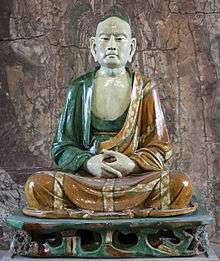 Room 33 - The luohan from Yixian made of glazed stoneware, China, 907-1125 AD
Room 33 - The luohan from Yixian made of glazed stoneware, China, 907-1125 AD Sculpture of the two Jain tirthankaras Rishabhanatha and Mahavira, Orissa, India, 11th-12th century AD
Sculpture of the two Jain tirthankaras Rishabhanatha and Mahavira, Orissa, India, 11th-12th century AD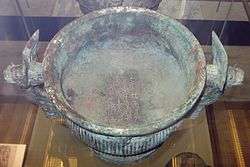 Room 33 - Western Zhou bronze ritual vessel known as the "Kang Hou Gui", China, 11th century BC
Room 33 - Western Zhou bronze ritual vessel known as the "Kang Hou Gui", China, 11th century BC Room 33 - A crowned figure of the Bodhisattva Khasarpana Avalokiteśvara, India, 12th century AD
Room 33 - A crowned figure of the Bodhisattva Khasarpana Avalokiteśvara, India, 12th century AD.jpg) Room 33 - Covered hanging jar with underglaze decoration, Si Satchanalai (Sawankalok), north-central Thailand, 14th-16th centuries AD
Room 33 - Covered hanging jar with underglaze decoration, Si Satchanalai (Sawankalok), north-central Thailand, 14th-16th centuries AD Room 33 - Hu-shaped altar flower vessel, Ming dynasty, China, 15th -16th centuries AD
Room 33 - Hu-shaped altar flower vessel, Ming dynasty, China, 15th -16th centuries AD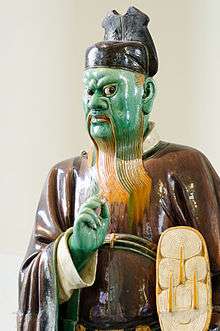 Room 33 - An assistant to the Judge of Hell, figure from a judgement group, Ming dynasty, China, 16th century AD
Room 33 - An assistant to the Judge of Hell, figure from a judgement group, Ming dynasty, China, 16th century AD Room 33 - Statue of Bodhisattva Avalokiteshvara, gilded bronze. Nepal, 16th century AD
Room 33 - Statue of Bodhisattva Avalokiteshvara, gilded bronze. Nepal, 16th century AD_001.jpg) Portrait of Ibrâhîm 'Âdil Shâh II (1580–1626), Mughal Empire of India, 1615 AD
Portrait of Ibrâhîm 'Âdil Shâh II (1580–1626), Mughal Empire of India, 1615 AD%2C_Courtesans_of_the_Tamaya_House.jpg) Room 90 - Courtesans of the Tamaya House, attributed to Utagawa Toyoharu, screen painting; Japan, Edo period, late 1770s or early 1780s AD
Room 90 - Courtesans of the Tamaya House, attributed to Utagawa Toyoharu, screen painting; Japan, Edo period, late 1770s or early 1780s AD- Room 33 - Statue of Buddha from Burma, 18th-19th century AD
 Room 33 - Figure of seated Lama; of painted and varnished papier-mâché, Ladakh, Tibet, 19th century AD
Room 33 - Figure of seated Lama; of painted and varnished papier-mâché, Ladakh, Tibet, 19th century AD
Department of Africa, Oceania and the Americas
.jpg)
The British Museum houses one of the world's most comprehensive collections of Ethnographic material from Africa, Oceania and the Americas, representing the cultures of indigenous peoples throughout the world. Over 350,000 objects[88] spanning thousands of years tells the history of mankind from three major continents and many rich and diverse cultures; the collecting of modern artefacts is ongoing. Many individuals have added to the department's collection over the years but those assembled by Henry Christy, Harry Beasley and William Oldman are outstanding. Objects from this department are mostly on display in several galleries on the ground and lower floors. Gallery 24 displays ethnographic from every continent while adjacent galleries focus on North America and Mexico. A long suite of rooms (Gallery 25) on the lower floor display African art. There are plans in place to develop permanent galleries for showcasing art from Oceania and South America.
Africa

The Sainsbury African Galleries display 600 objects from the greatest permanent collection of African arts and culture in the world. The three permanent galleries provide a substantial exhibition space for the museum's African collection comprising over 200,000 objects. A curatorial scope that encompasses both archaeological and contemporary material, including both unique masterpieces of artistry and objects of everyday life. A great addition was material amassed by Sir Henry Wellcome, which was donated by the Wellcome Historical Medical Museum in 1954. Highlights of the African collection include objects found at megalithic circles in The Gambia, a dozen exquisite Afro-Portuguese ivories, a series of soapstone figures from the Kissi people in Sierra Leone and Liberia, Asante goldwork and regalia from Ghana including the Bowdich collection, the rare Akan Drum from the same region in west Africa, the Benin and Igbo-Ukwu bronze sculptures, the beautiful Bronze Head of Queen Idia, a magnificent brass head of a Yoruba ruler and quartz throne from Ife, a similar terracotta head from Iwinrin Grove near Ife, the Apapa Hoard from Lagos, southern Nigeria, an Ikom monolith from Cross River State, the Torday collection of central African sculpture, textiles and weaponry from the Kuba Kingdom including three royal figures, the unique Luzira Head from Uganda, processional crosses and other ecclesiastical and royal material from Gondar and Magdala, Ethiopia following the British Expedition to Abyssinia, excavated objects from Great Zimbabwe (that includes a unique soapstone, anthropomorphic figure) and satellite towns such as Mutare including a large hoard of Iron Age soapstone figures, a rare divining bowl from the Venda peoples and cave paintings and petroglyphs from South Africa.
Oceania
The British Museum's Oceanic collections originate from the vast area of the Pacific Ocean, stretching from Papua New Guinea to Easter Island, from New Zealand to Hawaii. The three main anthropological groups represented in the collection are Polynesia, Melanesia and Micronesia – Aboriginal art from Australia is considered separately in its own right. Metal working was not indigenous to Oceania before Europeans arrived, so many of the artefacts from the collection are made from stone, shell, bone and bamboo. Prehistoric objects from the region include a bird-shaped pestle and a group of stone mortars from Papua New Guinea. The British Museum is fortunate in having some of the earliest Oceanic and Pacific collections, many of which were put together by members of Cook's and Vancouver's expeditions or by colonial administrators such as Sir George Grey, Sir Frederick Broome and Arthur Gordon, before Western culture significantly impacted on indigenous cultures. A poignant artefact is the wooden shield found near Botany Bay during Cook's first voyage in 1770. The Wilson cabinet of curiosities from Palau is another example of pre-contact ware. The department has also benefited greatly from the legacy of pioneering anthropologists such as Bronisław Malinowski and Katherine Routledge.
In addition, the Māori collection is the finest outside New Zealand with many intricately carved wooden and jade objects and the Aboriginal art collection is distinguished by its wide range of bark paintings, including two very early bark etchings collected by John Hunter Kerr. A particularly important group of objects was purchased from the London Missionary Society in 1911, that includes the unique statue of A'a from Rurutu Island, the rare idol from the isle of Mangareva and the Cook Islands deity figure. Other highlights include the huge Hawaiian statue of Kū-ka-ili-moku or god of war (one of three extant in the world) and the famous Easter Island statues Hoa Hakananai'a and Moai Hava.
Americas The Americas collection mainly consists of 19th and 20th century items although the Paracas, Moche, Inca, Maya, Aztec, Taino and other early cultures are well represented. The Kayung totem pole, which was made in the late nineteenth century on Haida Gwaii, dominates the Great Court and provides a fitting introduction to this very wide-ranging collections that stretches from the very north of the North American continent where the Inuit population has lived for centuries, to the tip of South America where indigenous tribes have long thrived in Patagonia. Highlights of the collection include Aboriginal Canadian objects from Alaska and Canada collected by the 5th Earl of Lonsdale and the Marquis of Lorne, the Squier and Davis collection of prehistoric mound relics from North America, a selection of pottery vessels found in cliff-dwellings at Mesa Verde, a collection of turquoise Aztec mosaics from Mexico (the largest in Europe), important artefacts from Teotihuacan and Isla de Sacrificios, several rare pre-Columbian manuscripts including the Codex Zouche-Nuttall and Codex Waecker-Gotter, a spectacular series of Mayan lintels from Yaxchilan excavated by the British Mayanist Alfred Maudslay, a very high quality Mayan collection that includes sculptures from Copan, Tikal, Tulum, Pusilha, Naranjo and Nebaj (including the celebrated Fenton Vase), a group of Zemi Figures from Vere, Jamaica, a number of prestigious pre-Columbian gold and votive objects from Colombia, ethnographic objects from across the Amazon region including the Schomburgk collection, two rare Tiwanaku pottery vessels from Lake Titicaca and important items from Tierra del Fuego donated by Commander Phillip Parker King.
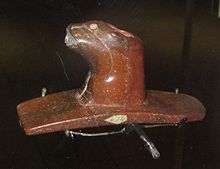 Room 26 - Stone pipe representing an otter from Mound City, Ohio, USA, 200 BC - 400 AD
Room 26 - Stone pipe representing an otter from Mound City, Ohio, USA, 200 BC - 400 AD Room 2 - Stone tomb guardian, part human part jaguar, from San Agustín, Colombia, c. 300-600 AD
Room 2 - Stone tomb guardian, part human part jaguar, from San Agustín, Colombia, c. 300-600 AD Room 1 - Maya maize god statue from Copán, Honduras, 600-800 AD
Room 1 - Maya maize god statue from Copán, Honduras, 600-800 AD_Quimbaya_Culture%2C_Colombia_AD_600-1100_-_British_Museum.jpg) Room 24 - Gold Lime Flasks (poporos), Quimbaya Culture, Colombia, 600-1100 AD
Room 24 - Gold Lime Flasks (poporos), Quimbaya Culture, Colombia, 600-1100 AD- Room 27 - Lintel 25 from Yaxchilan, Late Classic, Mexico, 600-900 AD
 Room 24 - Bird pectoral made from gold alloy, Popayán, Colombia, 900-1600 AD
Room 24 - Bird pectoral made from gold alloy, Popayán, Colombia, 900-1600 AD Room 24 – Rapa Nui statue Hoa Hakananai'a, 1000 AD, Wellcome Trust Gallery
Room 24 – Rapa Nui statue Hoa Hakananai'a, 1000 AD, Wellcome Trust Gallery.jpg) Room 27 - Double-headed serpent turquoise mosaic, Aztec, Mexico, 1400-1500 AD
Room 27 - Double-headed serpent turquoise mosaic, Aztec, Mexico, 1400-1500 AD.jpg)
 Room 2 - Miniature gold llama figurine, Inca, Peru, about 1500 AD
Room 2 - Miniature gold llama figurine, Inca, Peru, about 1500 AD Room 25 - Part of the famous collection of Benin brass plaques, Nigeria, 1500-1600 AD
Room 25 - Part of the famous collection of Benin brass plaques, Nigeria, 1500-1600 AD Room 25 - Detail of one of the Benin brass plaques in the museum, Nigeria, 1500-1600 AD
Room 25 - Detail of one of the Benin brass plaques in the museum, Nigeria, 1500-1600 AD Room 25 - Benin ivory mask of Queen Idia, Nigeria, 16th century AD
Room 25 - Benin ivory mask of Queen Idia, Nigeria, 16th century AD Room 24 - Hawaiian feather helmet or mahiole, late 1700s AD
Room 24 - Hawaiian feather helmet or mahiole, late 1700s AD- Great Court - Two house frontal totem poles, Haida, British Columbia, Canada, about 1850 AD
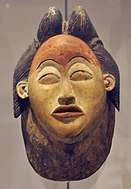 Room 25 - Mask (wood and pigment); Punu people, Gabon, 19th century AD
Room 25 - Mask (wood and pigment); Punu people, Gabon, 19th century AD Room 25 - Otobo masquerade in the Africa Gallery, Nigeria, 20th century AD
Room 25 - Otobo masquerade in the Africa Gallery, Nigeria, 20th century AD Room 25 - Modern interpretation of kente cloth from Ghana, late 20th century AD
Room 25 - Modern interpretation of kente cloth from Ghana, late 20th century AD
Department of Coins and Medals
The British Museum is home to one of the world's finest numismatic collections, comprising about a million objects, including coins, medals, tokens and paper money. The collection spans the entire history of coinage from its origins in the 7th century BC to the present day and is representative of both the East and West. The Department of Coins and Medals was created in 1861 and celebrated its 150th anniversary in 2011.[89]
Department of Conservation and Scientific Research
This department was founded in 1920. Conservation has six specialist areas: ceramics & glass; metals; organic material (including textiles); stone, wall paintings and mosaics; Eastern pictorial art and Western pictorial art. The science department[90] has and continues to develop techniques to date artefacts, analyse and identify the materials used in their manufacture, to identify the place an artefact originated and the techniques used in their creation. The department also publishes its findings and discoveries.
Libraries and archives
This department covers all levels of education, from casual visitors, schools, degree level and beyond. The museum's various libraries hold in excess of 350,000 books, journals and pamphlets covering all areas of the museum's collection. Also the general museum archives which date from its foundation in 1753 are overseen by this department; the individual departments have their own separate archives and libraries covering their various areas of responsibility, which can be consulted by the public on application. The Anthropology Library is especially large, with 120,000 volumes.[91] However, the Paul Hamlyn Library, which had become the central reference library of the British Museum and the only library there freely open to the general public, closed permanently in August 2011.[92] The website and online database of the collection also provide increasing amounts of information.
British Museum Press
The British Museum Press (BMP) is the publishing business and a division of the British Museum Company Ltd., a company and a charity (established in 1973) wholly owned by the trustees of the British Museum.[93]
The BMP publishes both popular and scholarly illustrated books to accompany the exhibition programme and explore aspects of the general collection. Profits from their sales goes to support the British Museum.[93]
Scholarly titles are published in the Research Publications series, all of which are peer-reviewed. This series was started in 1978 and was originally called Occasional Papers. The series is designed to disseminate research on items in the collection. Between six and eight titles are published each year in this series.[94]
Controversies

Artefacts taken from other countries
It is a point of controversy whether museums should be allowed to possess artefacts taken from other countries,[7][95] and the British Museum is a notable target for criticism. The Elgin Marbles, Benin Bronzes, Ethiopian Tabots and the Rosetta Stone are among the most disputed objects in its collections, and organisations have been formed demanding the return of these artefacts to their native countries of Greece, Nigeria, Ethiopia, and Egypt respectively. Parthenon Marbles claimed by Greece were also claimed by UNESCO among others for restitution. From 1801 to 1812, Elgin's agents took about half of the surviving sculptures of the Parthenon, as well as sculptures from the Propylaea and Erechtheum.
In recent years, controversies pertaining to reparation of artefacts taken from the Old Summer Palace in Beijing during the Anglo-French invasion of China in 1860 have also begun to surface.[96] Victor Hugo condemned the French and British for their plundering.[97] The British Museum and the Victoria and Albert Museum, among others, have been asked since 2009 to open their archives for investigation by a team of Chinese investigators as a part of an international mission to document lost national treasures. However, there have been fears that the United Kingdom may be asked to return these treasures.[98] As of 2010, Neil MacGregor, the Director of the British Museum, said he hoped that both British and Chinese investigators would work together on the controversial collection, which continues to result in resentment in China.[99]
The British Museum has refused to return these artefacts, stating that the "restitutionist premise, that whatever was made in a country must return to an original geographical site, would empty both the British Museum and the other great museums of the world".[100] The museum has also argued that the British Museum Act of 1963 legally prevents any object from leaving its collection once it has entered it. Nevertheless, it has returned items such as the Tasmanian Ashes after a 20-year-long battle with Australia.[101]
The British Museum continues to assert that it is an appropriate custodian and has an inalienable right to its disputed artefacts under British law.
Disputed items in the collection
- Elgin Marbles – claimed by Greece and backed by UNESCO among others for restitution[102]
- Benin Bronzes – claimed by Nigeria; the Nigerian government has passed a resolution demanding the return all the 700 bronze pieces.[103] 30 pieces of the bronzes were sold by the British Museum privately since the 1950s, mostly back to the Nigerians.[104]
- Ethiopian Tabots – claimed by Ethiopia[105][106]
- Four stolen drawings (Nazi plunder) – Compensation paid to Uri Peled for the amount of £175,000 by the British Museum[107]
- Achaemenid empire gold and silver artefacts from the Oxus Treasure – claimed by Tajikistan[108]
- Rosetta Stone – claimed by Egypt[109]
- Dunhuang manuscripts, part of a cache of scrolls, manuscripts, paintings, scriptures, and relics from the Mogao Caves, including the Diamond Sutra – claimed by the People's Republic of China[110]
- Gweagal Shield — claimed by Australia for the Gweagal people of New South Wales[111]
- Hoa Hakananai'a – claimed by Chile on behalf of Easter Island[112]
- Repatriation and reburial of human remains is a controversial issue, and the BM has issued a policy on the subject.[113]
Bag searches
In 2016, the British Museum moved its bag searches to marquees in the front courtyard and beside the rear entrance. This has been criticised by heritage groups as out-of-character with the historic building. The British Museum clarified that the change was purely logistical to save space in the main museum entrance and did not reflect any escalation in threat.[114]
BP sponsorship
The British Museum's relationship with the oil company BP, which has been a longstanding sponsor of the Museum, has been a source of controversy.
In May 2016, the British Museum was temporarily closed after Greenpeace climbers unfurled eight banners down the front columns of the British Museum in protest at BP's sponsorship of an exhibition about Ancient Egypt.[115]
In February 2019, hundreds of people occupied the British Museum in protest against BP's longstanding sponsorship of the Museum. Protestors also drew attention to the fact that BP lobbied the UK government to help it gain access to Iraq's oil reserves prior to Britain's invasion in 2003.[116]
In July 2019, Ahdaf Soueif resigned from the British Museum's board of trustees in response to its "immovable" position on its sponsorship deal with BP. Soueif claimed that the money BP provided to support British Museum exhibitions could be obtained elsewhere.[117]
In February 2020 1,500 demonstrators, including British Museum staff, took part in a day of protest about the BP sponsorship, occupying 11 of the museum's rooms. Protesters also smuggled a four-metre Trojan horse on to the museum's forecourt. The PCS union said the museum had a duty to recognise the escalating climate crisis and cut its ties with BP. In reply the museum said: “We are aware of the comments from the PCS union and will continue to liaise with the British Museum PCS branch and our staff more generally.”[118]
Trustee appointment
According to The Guardian, the UK government rejected the appointment of classicist Mary Beard as a British Museum trustee in 2019, due to her pro-European beliefs. This was a departure from the government's usual hands-off approach to the running of the museum. The newspaper said the British Museum subsequently planned to appoint her as one of the five trustees it does not need government approval for.[119]
Galleries
- Building
- Main Staircase, Discobolus of Myron (the Discus-Thrower)

 Ceiling of the Great Court and the black siltstone obelisks of Nectanebo II, c. 350 BC
Ceiling of the Great Court and the black siltstone obelisks of Nectanebo II, c. 350 BC Detail of an Ionic capital on a pilaster in the Great Court
Detail of an Ionic capital on a pilaster in the Great Court African Garden – created by BBC TV programme Ground Force
African Garden – created by BBC TV programme Ground Force
- Museum Galleries
Department of Ancient Egypt and Sudan
- Room 4 – Egyptian Sculpture, view towards the Assyrian Transept
- Room 4
- Room 4
Department of the Middle East
%2C_Centre_Island_%2B_North_Wall-_~_Assyrian_Empire_%2B_-Lamassu%2C_Stela's%2C_Statue's%2C_Obelisk's%2C_Relief_Panel's_%26_Full_Projection.1.jpg) The British Museum, Room 6 – Assyrian Sculpture
The British Museum, Room 6 – Assyrian Sculpture- Room 7 – Reliefs from the North-west palace of Ashurnasirpal II, Nimrud
- Room 89 – Nimrud & Nineveh Palace Reliefs
- Room 10 – Nineveh, The Royal Lion Hunt
Department of Greece and Rome
- Room 18 – Ancient Greece
 Room 20a – Tomb of Merehi & Greek Vases, Lycia, 360 BC
Room 20a – Tomb of Merehi & Greek Vases, Lycia, 360 BC- Room 85 – Portrait Sculpture, Roman
- Room 83 – Roman Sculpture
- Room 84 – Towneley Roman Sculptures
- Main Staircase – Discobolus, Roman
.jpg) Main Staircase – Townley Caryatid, Roman, 140–160 AD
Main Staircase – Townley Caryatid, Roman, 140–160 AD
Digital and online
The museum has a collaboration with the Google Cultural Institute to bring the collection online.[120]
Exhibitions
- Chronology of Temporary Exhibitions at the British Museum, by Joanna Bowring (British Museum Research Paper 189, 2012) lists all temporary exhibitions from 1838 to 2012.
Forgotten Empire Exhibition (October 2005 – January 2006)
- Room 5 – Exhibitions Panorama
 Room 5 – The Persepolis Casts
Room 5 – The Persepolis Casts- Room 5 – Exhibitions Relics
- Room 5 – The Cyrus Cylinder
See also
Notes
- Sculptures and applied art are in the Victoria and Albert Museum; the British Museum houses earlier art, non-Western art, prints and drawings. Art of a later date is at Tate Modern. The National Gallery holds the National Collection of Western European Art. Tate Britain holds British Art from 1500 onwards.
- By the Act of Parliament it received a name – the British Museum. The origin of the name is not known; the word 'British' had some resonance nationally at this period, so soon after the Jacobite rebellion of 1745; it must be assumed that the museum was christened in this light.[13]
- The estimated footage of the various libraries as reported to the trustees has been summarised by Harris (1998), 3,6: Sloane 4,600, Harley 1,700, Cotton 384, Edwards 576, The Royal Library 1,890.
- This was perhaps rather unfortunate as the title to the house was complicated by the fact that part of the building had been erected on leasehold property (the Crown lease of which ran out in 1771); perhaps that is why George III paid such a modest price (nominally £28,000) for what was to become Buckingham Palace. See Howard Colvinet al. (1976), 134.
- Understanding of the foundation of the National Gallery is complicated by the fact that there is no documented history of the institution. At first the National Gallery functioned effectively as part of the British Museum, to which the trustees transferred most of their most important pictures (ex. portraits). Full control was handed over to the National Gallery in 1868, after the Act of Parliament of 1856 established the Gallery as an independent body.
- Ashmole, the Keeper of the Greek and Roman Antiquities appreciated the original top-lighting of these galleries and removed the Victorian colour scheme, commenting:
The old Elgin Gallery was painted a deep terracotta red, which, though in some ways satisfactory, diminished its apparent size, and was apt to produce a depressing effect on the visitor. It was decided to experiment with lighter colours, and the walls of the large room were painted with what was, at its first application, a pure cold white, but which after a year's exposure had unfortunately yellowed. The small Elgin Room was painted with pure white tinted with prussian blue, and the Room of the metopes was painted with pure white tinted with cobalt blue and black; it was necessary, for practical reasons, to colour all the dadoes a darker colour[38]
- Ashmole had never liked the Duveen Gallery:
It is, I suppose, not positively bad, but it could have been infinitely better. It is pretentious, in that it uses the ancient Marbles to decorate itself. This is a long outmoded idea, and the exact opposite of what a sculpture gallery should do. And, although it incorporates them, it is out of scale, and tends to dwarf them with its bogus Doric features, including those columns, supporting almost nothing which would have made an ancient Greek artist architect wince. The source of daylight is too high above the sculptures, a fault that is only concealed by the amount of reflection from the pinkish marble walls. These are too similar in colour to the marbles...These half-dozen elementary errors were pointed out by everyone in the Museum, and by many scholars outside, when the building was projected.[42]
It was not until the 1980s that the installation of a lighting scheme removed his greatest criticism of the building. - The Cairo Museum has 200,000 artefacts, with leading collections reposited at the Egyptian Museum of Berlin (100,000), Musée du Louvre (60,000), Petrie Museum (80,000), The Metropolitan Museum of art (26,000), University of Pennsylvania (42,000), Ashmolean Museum (40,000), Museum of Fine Arts, Boston (40,000), Museo Egizio, Turin (32,500 objects).
References
- "Collection size". British Museum.
- Art Newspaper annual museum survey, 9 April 2020
- "About us". British Museum. Retrieved 26 March 2013.
- "History of the British Museum". The British Museum. Retrieved 12 July 2018.
- "The Life and Curiosity of Hans Sloane". The British Library. Retrieved 21 October 2017.
- "Admission and opening times". British Museum. 14 June 2010. Retrieved 4 July 2010.
- Tharoor, Kanishk (29 June 2015). "Museums and looted art: the ethical dilemma of preserving world cultures". The Guardian. Retrieved 18 April 2018.
- "The Big Question: What is the Rosetta Stone, and should Britain return". The Independent. 9 December 2009. Retrieved 2 April 2020.
- "BBC - History - British History in depth: Slavery and the Building of Britain". www.bbc.co.uk. Retrieved 12 November 2019.
- "Creating a Great Museum: Early Collectors and The British Museum". Fathom. Archived from the original on 2 January 2010. Retrieved 4 July 2010.
- "General history". British Museum. 14 June 2010. Retrieved 4 July 2010.
- Gavin R de Beer, Sir Hans Sloane and the British Museum (London, 1953).
- The question of the use of the term 'British' at this period has recently received some attention, e.g. Colley (1992), 85ff. There never has been a serious attempt to change the museum's name.
- Letter to Charles Long (1823), BMCE115/3,10. Scrapbooks and illustrations of the Museum. (Wilson, David, M.) (2002). The British Museum: A History. London: The British Museum Press, pg 346
- "The British Museum Images". Bmimages. Retrieved 4 July 2010.
- Dunton, Larkin (1896). The World and Its People. Silver, Burdett. p. 38.
- Wilson, David, M. (2002). The British Museum: A History. London: The British Museum Press. p. 25.
- Cavendish, Richard (January 2009). "The British Museum opened on January 15th, 1759". History Today. Vol. 59 no. 1.
- Rose, ED (15 April 2018). "Specimens, slips and systems: Daniel Solander and the classification of nature at the world's first public museum, 1753–1768" (PDF). British Journal for the History of Science. 51 (2): 205–237. doi:10.1017/S0007087418000249. PMID 29655387.
- "Collection Guides - King's Library". Retrieved 1 June 2020.
- Hoock, Holger (2010). Empires of the Imagination: Politics, War and the Arts in the British World, 1750–1850. Profile Books. p. 207. ISBN 9781861978592. Retrieved 21 July 2016.
- BMCE1/5, 1175 (13 May 1820). Minutes of General Meeting of the Trustees, 1754–63. (Wilson, David, M. (2002). The British Museum: A History, p. 78)
- Wondrous Curiosities – Ancient Egypt at the British Museum, pp. 66–72 (Stephanie Moser, 2006, ISBN 0-226-54209-2)
- The Story of the British Museum, p. 24 (Marjorie Caygill, 2003, ISBN 0-7141-2772-8)
- The British Museum – The Elgin Marbles, p. 85 (B.F.Cook, 2005, ISBN 0-7141-2134-7
- The British Museum – Assyrian Sculpture, pp. 6–7 (Julian Reade, 2004, ISBN 0-7141-2141-X)
- "King's Library". Bl. Retrieved 22 October 2011.
- Wilson, David, M. (2002). The British Museum: A History. London: The British Museum Press, p. 79
- The Story of the British Museum, p. 25 (Marjorie Caygill, 2003, ISBN 0-7141-2772-8)
- Reade, Julian (2004). Assyrian Sculpture. London: The British Museum Press, p. 16
- Dickens Charles Jr. (1879). "Museum, British". Dickens's Dictionary of London. Retrieved 22 August 2007.
Beyond the new Lycian room is the READING ROOM: [...]; circular structure; original suggestion of Thomas Watts, improved by A. (Sir A.) Panizzi, carried out by Mr. Sidney Smirke; [...]
- South from Ephesus – An Escape From The Tyranny of Western Art, pp. 33–34,(Brian Sewell, 2002, ISBN 1-903933-16-1)
- "The Electric Light in the British Museum" (PDF). The New York Times. 18 December 1879. Retrieved 15 January 2016.
- Caygill, Marjorie (2006). The British Museum: 250 Years. London: The British Museum Press, p. 5
- Caygill, Marjorie. "Creating a Great Museum: Early Collectors and The British Museum". Fathom. Archived from the original on 6 October 2007. Retrieved 13 November 2007.
- "British Museum – Collection search: You searched for". British Museum.
- Permanent establishment of the Research Laboratory (now the oldest such establishment in continuous existence) "History". British Museum.
- Quoted Ashmole (1994), 125
- Cook, B.F. (2005). The Elgin Marbles. London: The British Museum Press, pg 92
- Aronsfeld, C. C. (April 1984). "Judaica and Hebraica in German libraries: a review article". Journal of Librarianship and Information Science. 16 (2): 129–132. doi:10.1177/096100068401600204.
The Nazis, in fact, went to great lengths in exploiting Jewish (as well as general) literature. For instance, they arranged for a German researcher to spend several years at the British Museum for the purpose of compiling an anti-Semitic history of Anglo-Jewry, which, at the time, with its 562 pages and a bibliography of some 600 items, was an effort more ambitious than hitherto attempted.
- Wilson, David, M. (2002). The British Museum: A History. London: The British Museum Press, p. 270
- Ashmole (1994), 126
- Wilson, David, M. (2002). The British Museum: A History. London: The British Museum Press, p. 327
- "Room 25: Africa". British Museum. 14 June 2010. Retrieved 4 July 2010.
- "Search the collection database". British Museum. Retrieved 15 January 2014.
- Highlights British Museum, online research catalogues British Museum and online journals British Museum
- "British Museum gets record 6.7m visitors for 2013". BBC News. 14 January 2014. Retrieved 20 March 2014.
- Smithers, Rebecca (5 March 2014). "Sunny weather drew record numbers to UK's outdoor tourist hotspots in 2013". The Guardian.
- Miller, Joe (22 September 2014). "British Museum to be digitally recreated in Minecraft". BBC News. Retrieved 22 September 2014.
- "Directors". British Museum. 14 June 2010. Retrieved 4 July 2010.
- "Museum governance". British Museum. 14 June 2010. Archived from the original on 23 August 2007. Retrieved 4 July 2010.
- "Becoming a Trustee". British Museum. Retrieved 1 March 2014.
- Building the British Museum, Marjorie Caygill & Christopher Date 1999
- "Building London". University College London. Archived from the original on 7 December 2009. Retrieved 4 July 2010.
- Title deed of the 'perimeter properties' of The British Museum, BM Archives CA TD
- pp. 65–66, Building the British Museum, Marjorie Caygill & Christopher Date 1999
- Norman Foster and the British Museum, Norman Foster, Deyan Sudjic & Spencer de Grey 2001
- "British Museum Project". Waagner Biro. Archived from the original on 21 August 2011. Retrieved 22 October 2011.
- http://planningonline.camden.gov.uk/MULTIWAM/doc/Supporting%20Documents-2692368.pdf?extension=.pdf&id=2692368&location=VOLUME3&contentType=application/pdf&pageCount=1%5B%5D
- "Cross calls for new debate on stored collections". Museums Association. 26 January 2011. Archived from the original on 26 May 2012. Retrieved 26 June 2013.
- Huang, Jennifer; Kuo, Deborah (31 January 2007). "British Museum feels privileged to put exhibition in Taiwan". Taiwan Headlines. Government Information Office, Republic of China (Taiwan). Archived from the original on 28 September 2007. Retrieved 13 September 2010.
- Higgins, Charlotte (5 July 2007). "British Museum plans £100m complex for blockbusters". The Guardian. London. p. 10. Retrieved 5 July 2007.
- "British Museum unveils new £135 million wing". Design Week. 7 March 2014.
- "Franks House". British Museum. Retrieved 15 January 2014.
- "Development since World War II (1945 – )". British Museum. Retrieved 26 March 2013.
- "Department of Egypt and Sudan". British Museum. Retrieved 26 March 2019.
- Reported in the list of Sloane's collection given to his executors in 1753. Reproduced in MacGregor (1994a:29)
- "A British Museum Egyptologist's View: The Return of Egyptian Antiquities is Not an Issue". Touregypt. Retrieved 4 July 2010.
- "Ancient Egypt and Sudan". British Museum. 14 June 2010. Archived from the original on 6 February 2007. Retrieved 4 July 2010.
- "Department of Greece and Rome". British Museum. Retrieved 20 May 2019.
- Tony Kitto, "The celebrated connoisseur: Charles Townley, 1737–1805" Minerva Magazine May/June 2005, in connection with a British Museum exhibition celebrating the bicentennial of the Townley purchase. Townley marbles Burnley
- "British Museum – Research". britishmuseum.org.
- "Museum With No Frontiers". Discover Islamic Art. Retrieved 4 July 2010.
- "History of the Collection: Middle East". British Museum. 14 June 2010. Retrieved 4 July 2010.
- "Study room page". British Museum. 14 June 2010. Retrieved 4 July 2010.
- "Prints and Drawings galleries". British Museum. 14 June 2010. Retrieved 4 July 2010.
- Searches on 8 January 2012, return totals of 700,000, but many are in other departments
- Singh, Anita (29 November 2011). "City fund manager in £1m Picasso giveaway". The Daily Telegraph. Retrieved 19 May 2012.
- Katherine Gibson, 'The emergence of Grinling Gibbons as a statuary', published in Apollo, September 1999, p .28.
- British Museum Highlights
- BM Reindeer. page-flip.co.uk.
- "British Museum - Ain Sakhri lovers figurine". British Museum.
- Babs.Guthrie. "Collection page". Untold London. Archived from the original on 21 September 2009. Retrieved 4 July 2010.
- "Embassy of Japan in the UK". Japan Embassy. Archived from the original on 27 April 2011. Retrieved 4 July 2010.
- "Department of Asia". British Museum. 14 June 2010. Retrieved 4 July 2010.
- "Department of Asia – Related Highlight Objects". British Museum. 14 June 2010. Retrieved 4 July 2010.
- "Room 33a: Amaravati". British Museum. 14 June 2010. Retrieved 4 July 2010.
- "Africa, Oceania and the Americas". British Museum. 14 June 2010. Retrieved 4 July 2010.
- The British Museum and the Future of UK Numismatics. Proceedings of a conference held to mark the 150th anniversary of the British Museum’s Department of Coins and Medals, 2011, edited by Barrie Cook (British Museum Research Publication 183, 2011) ISBN 978-086159-183-1.
- "British Museum – Conservation and Scientific Research". thebritishmuseum.ac.uk.
- See the "Facilities and Services" tab on the home page for each department for details on each library; not all are kept at Bloomsbury. Anthropology Library
- "Paul Hamlyn Library". British Museum. Retrieved 22 October 2011.
- "About the BMP". Retrieved 2 March 2014.
- "Research Publications". Retrieved 2 March 2014.
- "Where it is safe to do so, cultural artefacts should be repatriated". The Economist. 23 February 2016. Retrieved 18 April 2018.
- Bowbly, Chris (2 February 2015). "The palace of shame that makes China angry". BBC News. Retrieved 3 January 2015.
- "The Chinese expedition: Victor Hugo on the sack of the Summer Palace". www.napoleon.org. Retrieved 3 January 2016.
- Foster, Peter (19 October 2009). "China to study British Museum for looted artefacts". The Telegraph. Retrieved 3 January 2015.
- Foster, Peter (15 November 2010). "British Museum 'welcomes investigation with Chinese over artefacts'". The Telegraph. Retrieved 15 January 2016.
- "Greek and Roman Antiquities". British Museum. 14 June 2010. Archived from the original on 23 May 2006. Retrieved 4 July 2010.
- "British museum agrees to return Aboriginal remains to Australia". USA Today. Associated Press. 16 October 2007. Retrieved 15 January 2016.
- "Breal's Silver Cup to be displayed at the New Acropolis Museum for one-year period from September 2012". BCRPM. Archived from the original on 27 July 2007. Retrieved 10 July 2007.
- Kennedy, Maev (28 March 2002). "British Museum sold precious bronzes". The Guardian. London. Retrieved 27 April 2010.
- "Benin bronzes sold to Nigeria". BBC. 27 March 2002.
- Johnson, Andrew (23 November 2008). "Ethiopia demands stolen crown back". Independent. Retrieved 24 August 2016.
- Hoffman, Barbara T. (2006). Art and Cultural Heritage: Law, Policy and Practice. Cambridge University Press. p. 5. ISBN 9780521857642.
- "News – Getting the Nazi stolen art back". Channel 4 News. 27 March 2007. Retrieved 4 July 2010.
- Harding, Luke (10 April 2007). "Tajik president calls for return of treasure from British Museum". The Guardian. London. Retrieved 27 April 2010.
- "Egypt calls for return of Rosetta Stone". BBC News. 21 July 2003. Retrieved 27 April 2010.
- Larmer, Brook (June 2010). "Caves of Faith". National Geographic: 136–138. Retrieved 15 January 2015.
- Daley, Paul (25 September 2016). "The Gweagal shield and the fight to change the British Museum's attitude to seized artefacts". The Guardian. Retrieved 3 May 2019.
- "Easter Islanders Ask British Museum to Return Sacred Statue, Offering Replica in Return". Hyperallergic. 23 October 2018. Retrieved 13 November 2018.
- "The British Museum policy on human remains". British Museum. Retrieved 6 May 2019.
- "Are the British Museum Bag Searches Getting Out of Hand? – Felix Magazine". Felix Magazine. 17 March 2017. Archived from the original on 20 March 2017. Retrieved 20 March 2017.
- Vaughan, Adam (19 May 2016). "Greenpeace activists scale British Museum to protest BP sponsorship". The Guardian. ISSN 0261-3077. Retrieved 17 July 2019.
- Busby, Mattha (16 February 2019). "Campaigners protest against BP sponsorship of British Museum". The Guardian. ISSN 0261-3077. Retrieved 17 July 2019.
- "Trustee resigns from British Museum over BP". 16 July 2019. Retrieved 17 July 2019.
- "British Museum staff join outcry against BP sponsorship". The Guardian. 10 February 2020. Retrieved 5 March 2020.
- "Mary Beard blocked by No 10 as British Museum trustee 'for pro-Europe views'". The Guardian. 1 March 2020. Retrieved 5 March 2020.
- "British Museum Online".
Further reading
- Anderson, Robert (2005). The Great Court and the British Museum. London: The British Museum Press
- Arrowsmith, Rupert Richard. Modernism and the Museum: Asian, African and Pacific Art and the London Avant Garde. Oxford University Press, 2011, pp. 103–164. ISBN 978-0-19-959369-9.
- Arrowsmith, Rupert Richard. "The Transcultural Roots of Modernism: Imagist Poetry, Japanese Visual Culture, and the Western Museum System", Modernism/modernity Volume 18, Number 1, January 2011, pp. 27–42. ISSN 1071-6068.
- Bowring, Joanna (2012). Chronology of Temporary Exhibitions at the British Museum London: British Museum Research Paper 189.
- Caygill, Marjorie (2006). The British Museum: 250 Years. London: The British Museum Press
- Caygill, Marjorie (2002). The Story of the British Museum. London: The British Museum Press
- Cook, B. F. (2005). The Elgin Marbles. London: The British Museum Press
- Esdaile, Arundell (1946) The British Museum Library: a Short History and Survey. London: Allen & Unwin
- Jacobs, Norman (2010) Behind the Colonnade. Stroud: The History Press
- Jenkins, Ian (2006). Greek Architecture and its Sculpture in The British Museum. London: The British Museum Press
- Francis, Frank, ed. (1971) Treasures of the British Museum. London: Thames & Hudson (rev. ed., 1975)
- Moser, Stephanie (2006). Wondrous Curiosities: Ancient Egypt at The British Museum. Chicago: The University of Chicago Press
- Reade, Julian (2004). Assyrian Sculpture. London: The British Museum Press
- Reeve, John (2003). The British Museum: Visitor's Guide. London: The British Museum Press
- Wilson, David M. (2002). The British Museum: a history. London: The British Museum Press
External links
| Wikimedia Commons has media related to: |
